
CC450
Digital Camera
User Manual

CC450
Digital Camera
User Manual


I

II

Preface
About this Manual
This manual is designed to assist you in using your new digital camera. All information presented is as accurate as possible but is subject to change without notice.
For the latest reversion, please visit www.hp.com/support.
Copyright
This manual contains proprietary information protected by copyright. All rights are reserved. No part of this manual may be reproduced by any mechanical, electronic or other means, in any form, without prior written permission of the manufacturer. ?? Copyright 2010
Federal Communications Commission (FCC) Compliance
This equipment has been tested and found to comply with the limits for a Class B digital device, pursuant to Part 15 of the FCC Rules. These limits are designed to provide reasonable protection against harmful interference in a residential installation. This equipment generates, uses, and can radiate radio frequency energy and, if not installed and used in accordance with the instructions, may cause harmful interference to radio communications. However, there is no guarantee that interference will not occur in a particular installation. If this equipment does cause harmful interference to radio or television reception, which can be determined by turning the equipment off and on, the user is encouraged to try to correct the interference by one or more of the following measures:
???Reorient or relocate the receiving antenna.
???Increase the distance between the equipment and the receiver.
???Connect the equipment to an outlet on a circuit different from that to which the receiver is connected.
???Consult the dealer or an experienced radio/TV technician for help.
Declaration of Conformity
This device complies with Part 15 of the FCC rules. Operation is subject to the following conditions:
???This device may not cause harmful interference.
???This device must accept any interference received, including interference that may cause undesired operation.
Trademark Recognition
Windows 2000/XP/Vista/Windows 7 are registered trademarks of Microsoft Corporation in the United States and/or other countries. Macintosh and Mac OS are registered trademarks of Apple Inc. In addition, all other companies or product names are trademarks or registered trademarks of their respective companies.
1

Safety and Handling Precautions Camera Information
???Do not take apart or attempt to service the camera yourself.
???Do not expose the camera to moisture, or extreme temperatures.
???Allow the camera to warm up when moving from cold to warm temperatures.
???Do not touch the camera lens.
???Do not expose the lens to direct sunlight for extended periods.
???Do not use abrasive chemicals, cleaning solvents or strong detergents to clean the product. Wipe the product with a clean slightly damp soft cloth.
Battery Information
???The HP CC450 camera uses 2 - AA batteries. For optimal performance and battery life, please use photo lithium.
???Turn off the camera before installing or removing the batteries.
???When the camera is used for an extended period of time, it is normal for the camera body to feel warm.
???Do not remove the batteries while downloading pictures, videos, or audio content. This could result in a complete loss of these items.
???It is recommended to remove the batteries if the camera will not be used for a long period of time.
???When inserting the batteries in this camera, ensure that they are oriented correctly. Please see Inserting the Batteries section of this manual for additional details. Inserting the batteries incorrectly may cause damage to the camera and batteries.
???An single depleted or low battery power level may cause the lens to not extend or retract properly.
???Dispose of used batteries according to their instructions.
Important Notes and Information
Throughout this manual, look for the symbols below that highlight useful and important information.
This symbol will be used to indicate useful information when using the camera.
This symbol will be used to indicate important message that should be read before using the function.
2

Photography Terms and Definitions
3

Source: ISO/WE 12231
4

Specifications
5
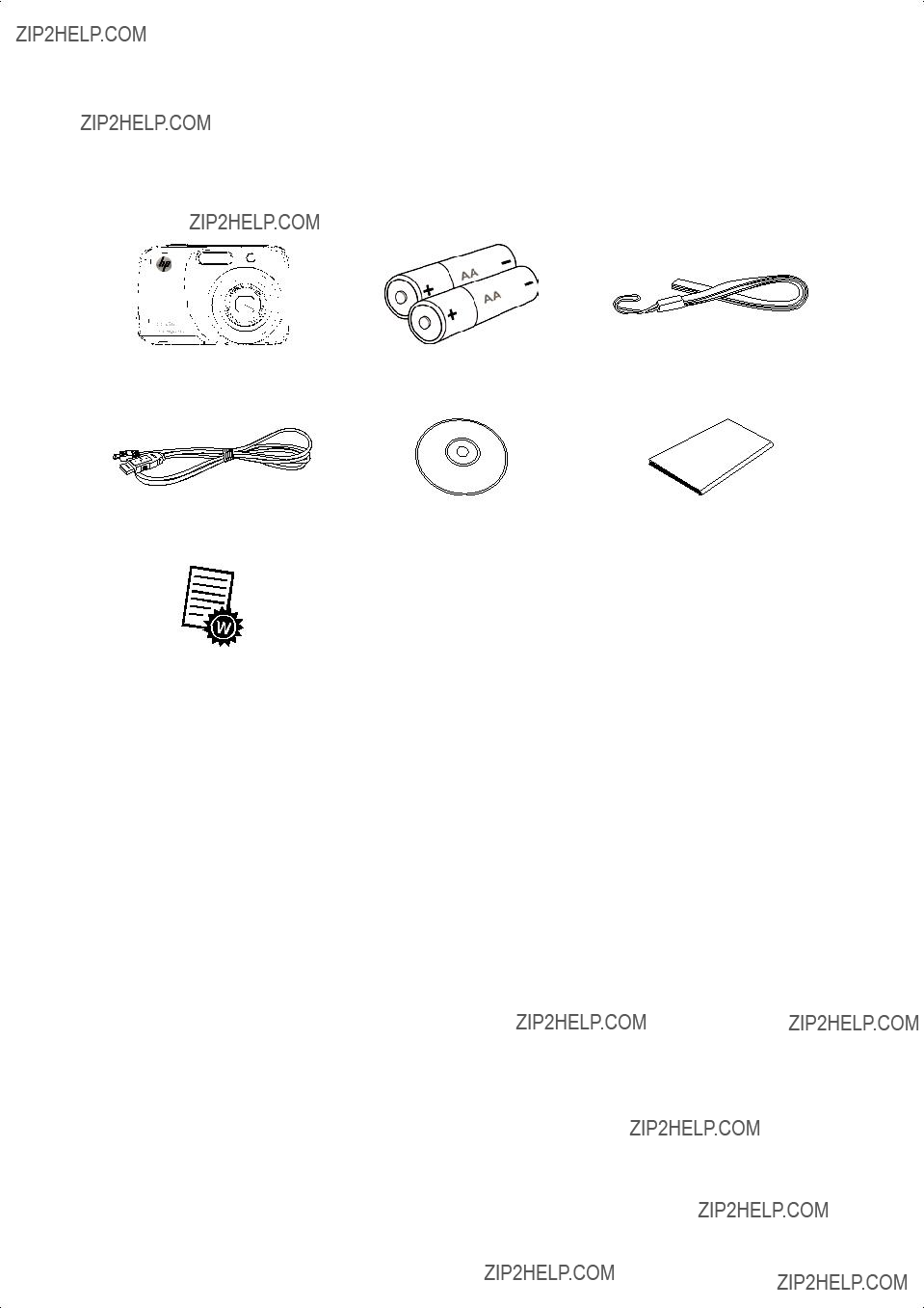
Package Contents
Please check the contents of your camera package. It should contain:
Warranty card
6

Getting Started
Attach the Camera Strap
To reduce the risk of dropping the camera, it is strongly recommended to attach and use the provided camera strap.
Inserting the Batteries
Follow these instructions to insert the batteries into the battery/memory card compartment. Please read "Battery Information" on page 2 before inserting/removing batteries.
1.If the batteries are already installed, make sure to power off the camera before removing and inserting recharged or new batteries.
2.Open the battery/memory card compartment at the bottom of the camera as illustrated.
3.Insert the batteries into the compartment with correct orientation as illustrated.
4. Close and secure the battery/memory card compartment.
7

Inserting an SD/SDHC Memory Card
It is highly recommended that the camera storage is expanded by inserting a SD or SDHC memory card. These memory cards are available at most consumer store and online locations.
1.Make sure to power off the camera before proceeding. Inserting the memory card while powered on may damage the card and camera.
2.Open the Battery/memory card compartment at the bottom of the camera.
3.Insert the SD/SDHC card into the memory card slot with the metallic connectors facing the front side of the camera as illustrated below.
4.Push the SD/SDHC card into the memory slot until it clicks into place. If the card does not click into place, repeat the previous step to ensure proper orientation.
5.Close the Battery/memory card compartment.
To remove the SD/SDHC card
1.Make sure to power off the camera before proceeding. Removing the memory card while powered on may damage the card and camera.
2.Open the battery/memory card compartment.
3.Gently push the card until it clicks and pushes our of position.
4.Carefully pull out the card.
Camera Memory
Internal memory
This camera is equipped with 32MB of internal memory. However, storage of images, video and audio clips is limited to approximately 12MB. For optimal use, it is strongly recommend that this camera is used with SD or SDHC memory cards. If there is no SD or SDHC memory card inserted in the memory card slot, all images, videos and audio clips recorded are automatically stored in the internal memory.
External storage
This camera supports SD cards of up to 4GB, and SDHC cards with a maximum capacity of 32GB. It is strongly recommended that Class 4 or above memory cards are used with this camera. Consult the reseller or manufacturer of the memory card for class rating details.
If a SD/SDHC card is inserted in the memory slot, the camera automatically saves all images, videos and audio clips to this storage card. The LCD memory card icon  indicates the camera is using SD card.
indicates the camera is using SD card.
Not all SD/SDHC memory cards may be compatible with this camera. When
purchasing a card, please verify the card???s speci???cations.
8

Camera Views
Front View
1
2
4
Back View
Top View
13
12.Stabilizer button
13.Speaker
14.Shutter button
15.Power button
9

Bottom View
16.Tripod screw hole
17.Battery/Memory compartment door
Left/Right View
18
19
18.USB/TV Out
19.Strap ring
10

Camera Buttons
Navigation Control
The
1
5
3
No. Description
1 Face Tracking, Photo Rotation, and up direction
2 Macro/Focus mode selector and left direction
3 Display mode selection and down direction
4 Flash mode / right direction
5OK Button
1. Press to confirm a selection when using the OSD menus.
1.In Photo Mode, press to cycle through the flash mode options.
( Auto,
Auto,  Anti
Anti  Slow Sync,
Slow Sync,  Forced On and
Forced On and  Forced Off)
Forced Off)
3.During playback of recorded video clips, press to fast forward.
4.In Menu and Settings mode, press to enter the submenu or to navigate through the menu selections.
11

1.In Photo Mode, press to cycle through Macro and other focus options.
(
 Macro,
Macro,  Pan focus and
Pan focus and  Infinity) See pages
Infinity) See pages
Macro/Left
2.In Playback mode, press to view the previous image, video or audio clip.
3.During playback of recorded video clips, press to rewind.
4.In Menu, press to exit a submenu or to navigate through the menu selections.
1.In Photo Mode, press to turn the face tracking function on and off.
1.In Photo Mode, press to change the LCD screen display information. Continue to press to cycle through the display options. See page 12 for additional details.
2.In Playback Mode, press to change the display of photo, video, or audio
3.During playback of recorded video or audio clips, press to stop the playback.
4.In Menu, press to navigate through the menu and submenu selections.
Turning the Power On and Off
Press the Power button  to power on and off the camera.
to power on and off the camera.
???If the mode selector switch is set to Photo or Video mode, the startup image displays briefly and the startup sound plays if enabled. The camera lens extends and the camera is ready for use.
???If the mode selector switch is set to Playback mode, the last recorded photo, video clip, or audio clip will be displayed and the lens will not be extended.
To turn off the camera, press the Power button  or the camera will automatically shut off when not used for the selected Power Save (see page 62 for details) setting. The default setting is after 1 minute of inactivity.
or the camera will automatically shut off when not used for the selected Power Save (see page 62 for details) setting. The default setting is after 1 minute of inactivity.
12

Initial Settings
When the camera is powered up for the first time, please set the display language and date & time.
Setting the Language
1. Press directional buttons to move through the selection.
Setting the Date & Time
1.Press left and right direction buttons to move through the selection.
2.Press the up and down buttons to change the value for the date and time.
At this point, the camera settings are set to the default automatic mode and is ready to take photos and videos.
???If the camera is without battery power for more than 48 hours, the initial settings may reset and require another setup.
Modes Selector Switch
This camera has a three mode selector switch. The different modes are:
Photo Mode
???Slide the mode switch to [  ] take photos and record audio clips by selecting Voice REC from scene modes (see pages 12 for additional details).
] take photos and record audio clips by selecting Voice REC from scene modes (see pages 12 for additional details).
Video Mode
??? Slide the mode switch to [  ] record videos (see page 29 for additional details).
] record videos (see page 29 for additional details).
Playback Mode
???Slide the mode switch to [  ] view and edit captured images or playback videos and audio clips. The recording of voice memo attached to images is also available in this mode.
] view and edit captured images or playback videos and audio clips. The recording of voice memo attached to images is also available in this mode.
13
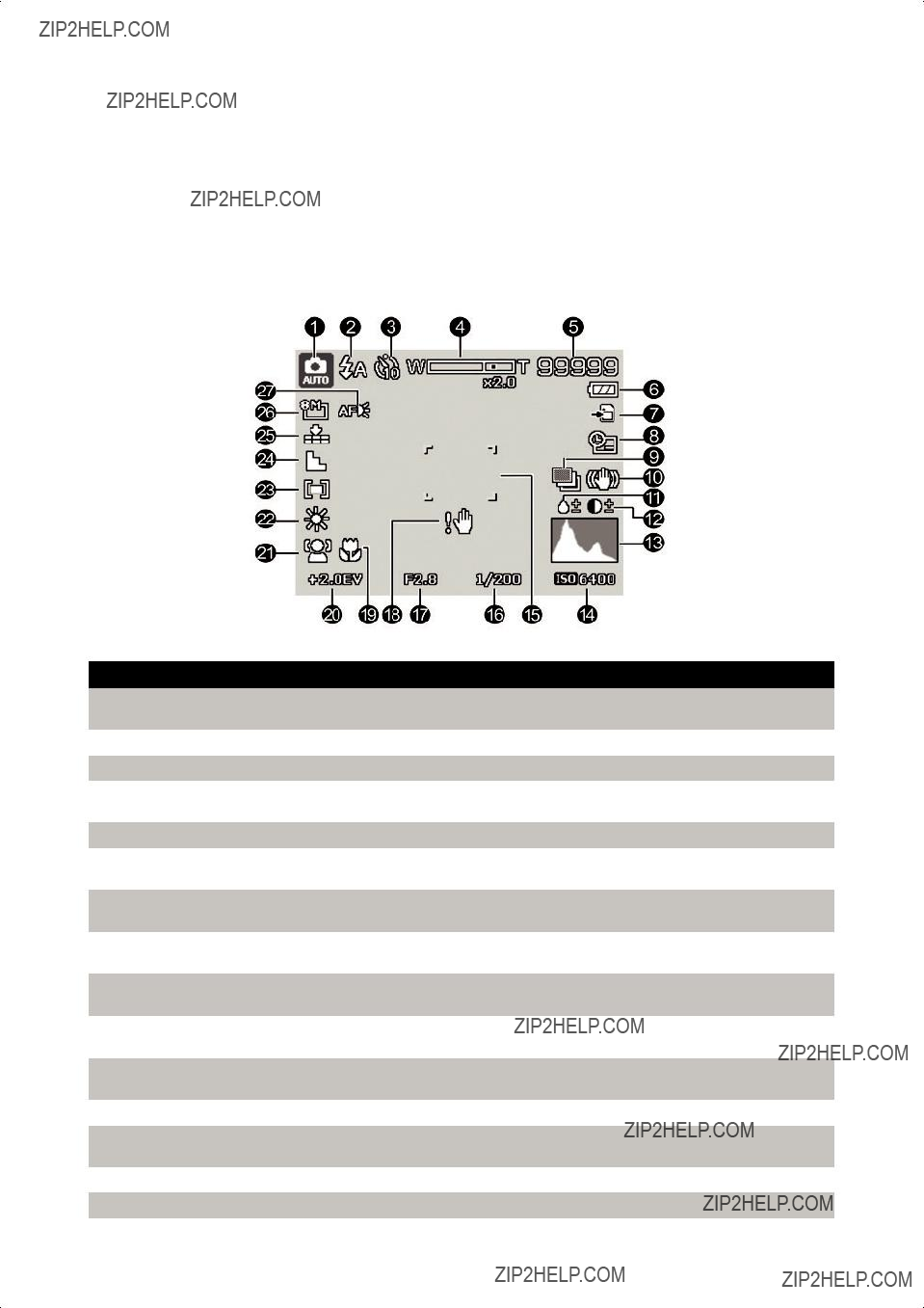
Understanding the LCD Screen
The LCD monitor shows all important information regarding camera settings as well as the visual image of your image or video. The display on the LCD monitor is called the On Screen Display or OSD.
LCD Screen Layout
Photo Mode Screen Layout
14

15

Video Mode Screen Layout
The
16

Playback Mode Screen Layout
The Playback mode display varies depending on the type of image being viewed.
Playback mode display of photos:
17
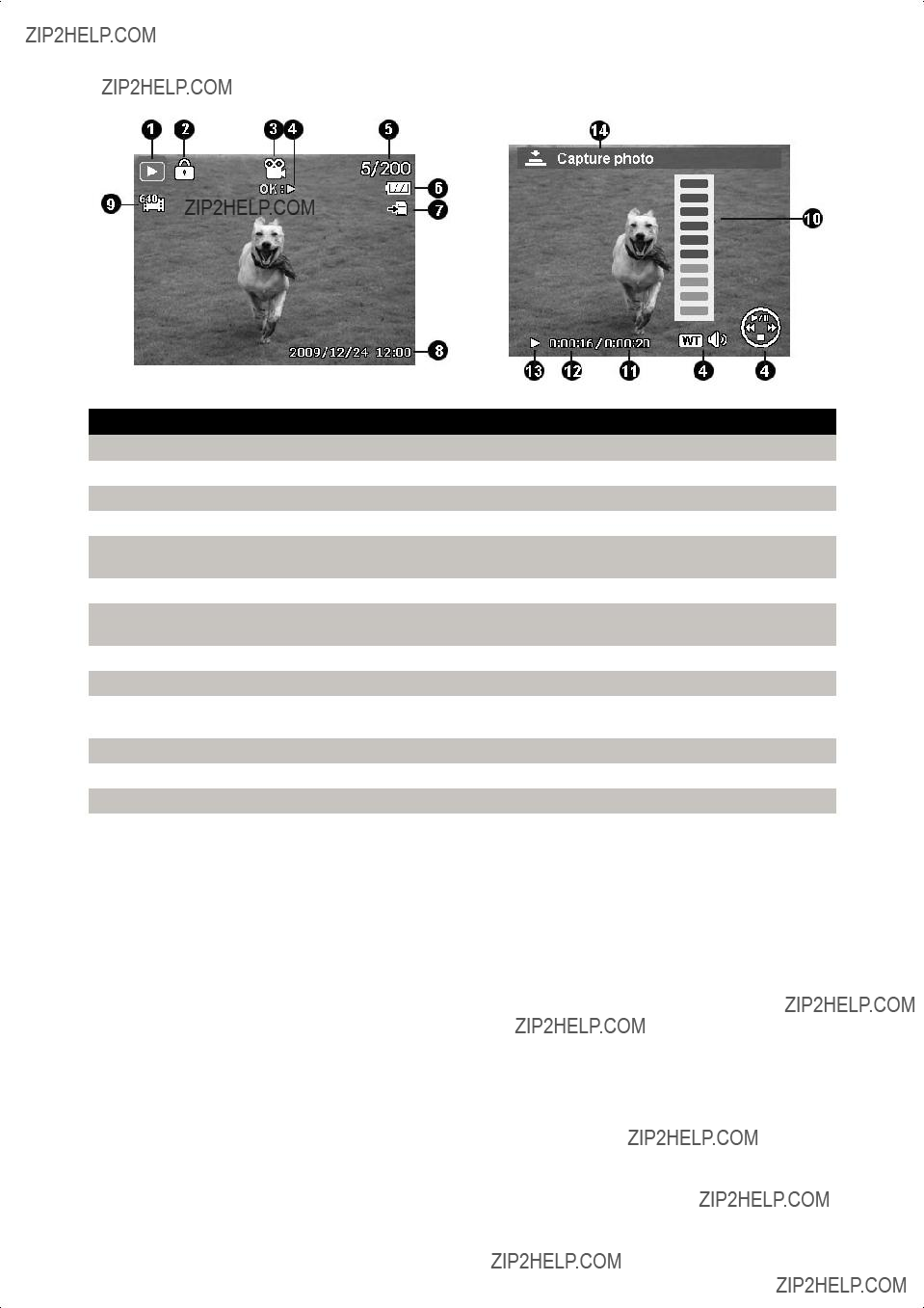
Playback mode of videos:
18

Playback mode of audio clips:
19

Changing the LCD Display
The type of information displayed on the LCD monitor can be changed using the 
 button. Press the
button. Press the 
 button repeatedly to change the LCD display from one type to another. In Photo/Movie Mode, the LCD display can be changed into any of the following:
button repeatedly to change the LCD display from one type to another. In Photo/Movie Mode, the LCD display can be changed into any of the following:
???Basic
???Full
???Minimal
???Guidelines
???No icons or information
???The OSD information may vary depending on the record mode type.
???Use the ???Guide lines??? to properly set image for capture. Typically, these guide lines are used to help vertical and horizontal alignment of the photo.
In Playback mode, the LCD display can be changed into any of the following:
???Basic
???Full
???No icons or information
LCD display cannot be changed in the following situations:
???While recording movie or audio clips
???During playing movie or audio clips
???Playing slideshow
20

Recording Photos, Movies and Voices
Taking Photos
This camera is designed to make the experience of taking photos simple and quick. It???s Auto mode feature will optimise the internal settings so that in most situations, it can take photos with ease. This camera also has additional modes and features that extend the capabilities for the more experienced user.
1.Power on the camera by pressing the Power button  .
.
2.Slide the Mode switch to Photo mode  .
.
3.Frame the shot using the focus bracket on the LCD monitor.
4.Lightly pressing the Shutter button  down to the halfway position will start the automatic focus and adjustments to the exposure level. When the camera has successfully completed this automatic routine, the focus bracket will turn green. If the automatic focus and exposure routine is not successful, the bracket will turn red. If this occurs, simply release the shutter and repeat this step until the bracket
down to the halfway position will start the automatic focus and adjustments to the exposure level. When the camera has successfully completed this automatic routine, the focus bracket will turn green. If the automatic focus and exposure routine is not successful, the bracket will turn red. If this occurs, simply release the shutter and repeat this step until the bracket
turns green. In some situations, lighting and contrast may be insufficient for the camera to successfully complete the auto focus and exposure level routine. If this occurs, try better lighting.
5.Pressing the Shutter button  down fully will take the photo. If you take the photo when the bracket is red, the focus and exposure may not be correct.
down fully will take the photo. If you take the photo when the bracket is red, the focus and exposure may not be correct.
If the shake warning icon  appears, hold the camera steadily, with your arms at your side or use a tripod to stabilize the camera to reduce the risk of blurred photos.
appears, hold the camera steadily, with your arms at your side or use a tripod to stabilize the camera to reduce the risk of blurred photos.
21

Recording Videos
This camera is capable of recording videos. Since video recording requires significant memory capacity, it is highly recommended to use SD/SDHC cards with this feature. The available recording time depends on the capacity of the memory card. Videos can be recorded until the maximum memory capacity has been reached. However the length of a single video clip is limited to 4 GB. To increase the recording length, lower the video quality settings (See page 26 for details).
1.Power on the camera by pressing the Power button  .
.
2.Slide the Mode switch to Video mode  .
.
3.Lightly pressing the Shutter button  down to the halfway position will start the automatic focus and adjustments the exposure level. When the camera has successfully completed this automatic routine, the focus bracket will turn green. If the automatic focus and exposure routine is not successful, the bracket will turn red. If this occurs, simply release the shutter and repeat this step until the bracket turns green. In some situations, lighting and contrast may be insufficient for the camera to successfully complete the auto focus and exposure level routine. If this occurs, try better lighting.
down to the halfway position will start the automatic focus and adjustments the exposure level. When the camera has successfully completed this automatic routine, the focus bracket will turn green. If the automatic focus and exposure routine is not successful, the bracket will turn red. If this occurs, simply release the shutter and repeat this step until the bracket turns green. In some situations, lighting and contrast may be insufficient for the camera to successfully complete the auto focus and exposure level routine. If this occurs, try better lighting.
4.Pressing the Shutter button  down fully will begin the video recording.
down fully will begin the video recording.
5.Use the Zoom buttons  to zoom in and zoom out.
to zoom in and zoom out.
6.To pause recording, press the key 

 .
.
7.To continue recording, press the key 

 again.
again.
8.To stop recording, press the Shutter button  down fully.
down fully.
???When the camera stops recording due to reaching maximum capacity (4GB) for a single video clip, simply press the Shutter button again to continue recording. To increase the recording length, lower the video quality settings (See page 26 for details).
???The camera will automatically stop recording when the memory capacity is full.
???Digital zoom is not available while recording a video.
???Sound cannot be recorded while pressing the Zoom buttons  .
.
???Power save is not available in video recording or pause recording.
22

Using the Stabilizer Feature
The Stabilizer feature is for Photo mode only. This feature is designed to help reduce the blurring effects on photos caused by slight camera movement. It is important to note that this feature cannot compensate for all movement and lighting situations and that in many cases may slow the camera???s ability to auto focus.
How does it work? It works according to the luminance of the target object. This function uses special image data processing to optimise the high sensitivity of CCD sensor (also known as the digital film). High sensitivity allows the use of faster shutter speeds compared to the default mode, so it may reduce blurring caused by camera movement.
Stabilizer button
To activate Stabilizer
???Press the Stabilizer button 
 located on the top of the camera to enable/disable stabilizer.
located on the top of the camera to enable/disable stabilizer.
If Stabilizer is enabled, the stabilizer icon is displayed on
the LCD screen and the ISO setting is automatically setStabilizer on to Automatic. See ???ISO??? on page 28 for more details.
Setting the Zoom Control
Using a combination of 4 times optical zoom and 5 times digital zoom permits zoom photography at up to 20 times magnification. While the digital zoom can be a useful feature, the more an image is enlarged (zoomed), the more pixelated (grainier) the image may appear. Please refer to ???Setting the Digital Zoom??? on page 23 on how to setup digital zoom.
To adjust the optical zoom:
1.Press the Zoom buttons  to zoom in or zoom out.
to zoom in or zoom out.
2.The zoom indicator appears on the LCD monitor  .
.
Zoom buttons
1. Press the ???T??? button to zoom in.
2. Press the ???W??? button to zoom out.
To adjusts the digital zoom:
1.Activate digital zoom. See ???Setting the Digital Zoom??? on page 23.
2.Press the T button  to optically zooms in until maximum 4X limit is reached.
to optically zooms in until maximum 4X limit is reached.
3.Momentarily stop pressing the T button then press again to now initiate the Digital Zoom feature  .
.
4.Pressing the W button will zoom out until and return the camera to optical zoom.
23

Optical zoom 1X to 4X
Digital zoom 1X to 5X
???Digital zoom is not available for video recording.
???Slight camera movement in digital zoom will make it more dif???cult to focus on objects/subjects. Use of a tripod can reduce this issue.
Using the Flash Features
By default, this camera is set to automatic flash mode which means that it will determine when to use this feature or not. However, is some situations, it may be useful to manually select the appropriate flash mode. When taking
pictures in difficult lighting conditions, use the Flash button  to select the desired mode. This function cannot be activated while recording videos or continuous shooting.
to select the desired mode. This function cannot be activated while recording videos or continuous shooting.
To activate Flash:
???Press the Flash/Right button on your camera repeatedly until your desired flash mode is displayed on the LCD
 AUTO.
AUTO.
The flash fires automatically whenever the camera determines extra lighting is needed. This is the default mode of the camera.

The flash fires twice to help reduce the
 Forced on.
Forced on.
The flash fires whenever you press the Shutter button regardless of lighting conditions. This may be useful in some bright backlight situations.
24
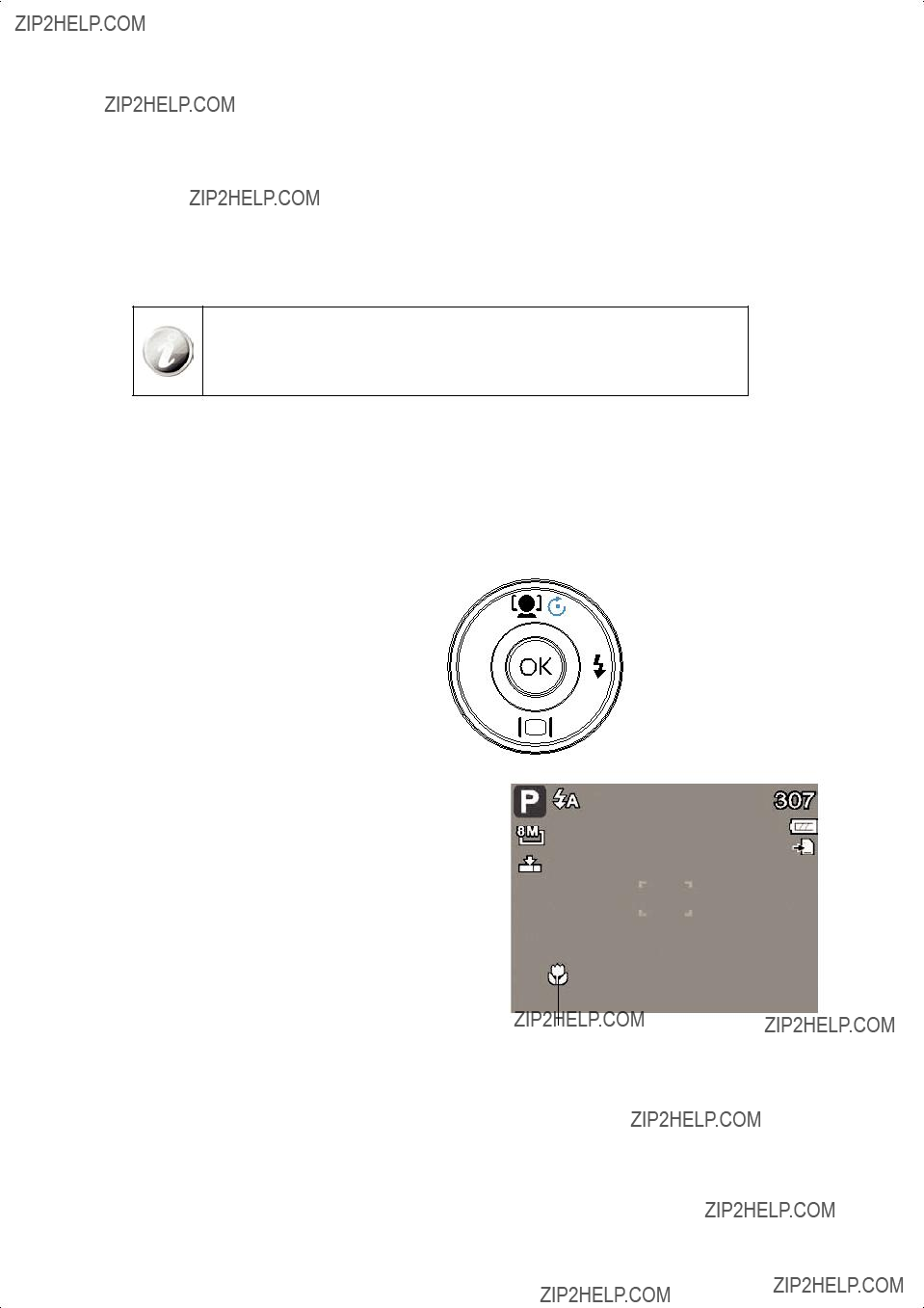
 Slow sync.
Slow sync.
This would be used to capture a dimly lit background while keeping the foreground (subject) properly lighted. This flash mode forces the camera to use a slower shutter speed in combination with the flash. The flash fires briefly to light the foreground (subject) while capturing ambient light to reveal more detail in the background. If Slow Sync flash is not used, the background may appear black or underexposed.
 Forced off.
Forced off.
The flash is turned off and will not fire regardless of the lighting situation. In low light situations, the use of a tripod may be required to reduce photo blurring.
???Flash function is only available in shooting still images but not available in Burst and AEB modes.
???Do not try to change the ???ash while pressing the zoom button. Change the ???ash after releasing the zoom button if necessary.
Setting the Focus Mode
This function allows users to define the type focus when recording a still image or a video clip.
To set the Focus mode
???Press the Macro button repeatedly until the desired focus mode icon is displayed on the lower left corner of the LCD monitor.
Macro/left button 

This camera supports the following four focus modes:
Normal.
With normal focus, the focus range starts from 0.4m (about 16 inches) to near infinity. When the camera is set to Normal mode, there is no icon displayed on the screen.

 Macro.
Macro.
This mode is designed for
Macro enabled
25
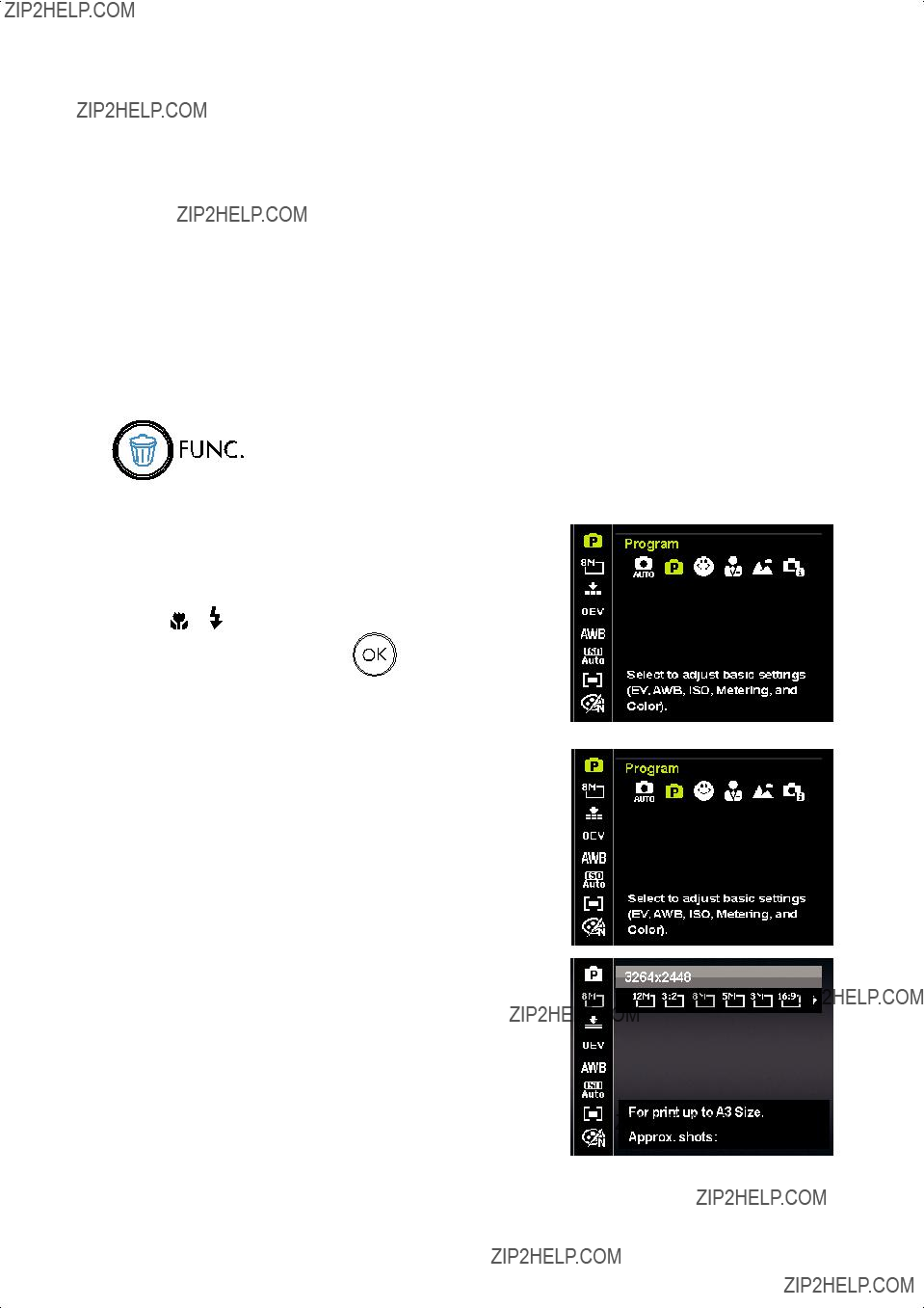
 Pan Focus.
Pan Focus.
This mode is designed to accurately focus on a desired subject so that closer and further objects are out of focus. For example, the camera might focus on a nearby tree, and the distant trees and mountains are blurry, as well as an even closer object such as a flower.
 Infinity.
Infinity.
When Infinity is set, the camera focuses on distant objects. This may be good to use when taking landscape photos.
Using the Function Menu
The Function Menu is used to quickly adjust basic capture settings while in Photo and Video mode. In Photo mode, the Function menu displays the last 6 scene modes used as well as allow changes to be made in resolution and file compression quality settings, (EV compensation, Auto White Balance (AWB), ISO settings, Metering, and Color mode may be available for different scene modes). In Video mode, the function menu displays and allows changes to be made to Video resolution setting, AWB, Metering, and Color mode.
Press the FUNC button of your camera to launch the Function Menu.
Press the FUNC button again to close the menu.
???The available options for each item on the menu bar are shown in the Menu options.
My Mode
The My Mode function displays the 6 most recent modes used in order. When moving through the different modes in the menu options, the items on the menu bar changes synchronously to the corresponding available settings.
Photo Size
The Photo Size function is used to set the resolution before taking the photo. Changing the Photo Size affects the number of images that can be stored in memory. The higher the resolution, the more memory space is required.
26

The table below shows the Photo Size values for still images:
Quality
This allows the quality (compression) at which the photo is captured to be increased or decreased. The quality determines the amount of compression applied to the photos. Superfine setting results in a more detailed image. However, the higher the quality, the more memory space is required in memory.
EV Compensation
Images can be captured with the overall scene intentionally made brighter or darker. These settings are used when
a suitable brightness (exposure) cannot otherwise be obtained in circumstances where the difference in
brightness between the subject and the background (the contrast) is large, or when the subject that you wish to capture is very small within the scene. Available for still images only.
???To adjust EV settings, press the 
 or
or  keys to increase/decrease the value. As adjustments to the settings are
keys to increase/decrease the value. As adjustments to the settings are
made, the LCD screen synchronously displays the image applying the EV settings. Press the OK button to save and apply changes.
???The available settings are: 0EV / +2.0EV / +1.7EV / +1.3EV / +1.0EV / +0.7EV / +0.3EV / 0EV /
White Balance
This sets the white balance for a variety of lighting conditions and permits photos to be captured to the desired level.
???As adjustments to the settings are made, the LCD screen synchronously displays the image applying the
???Below is a table with a description of the different settings.
27
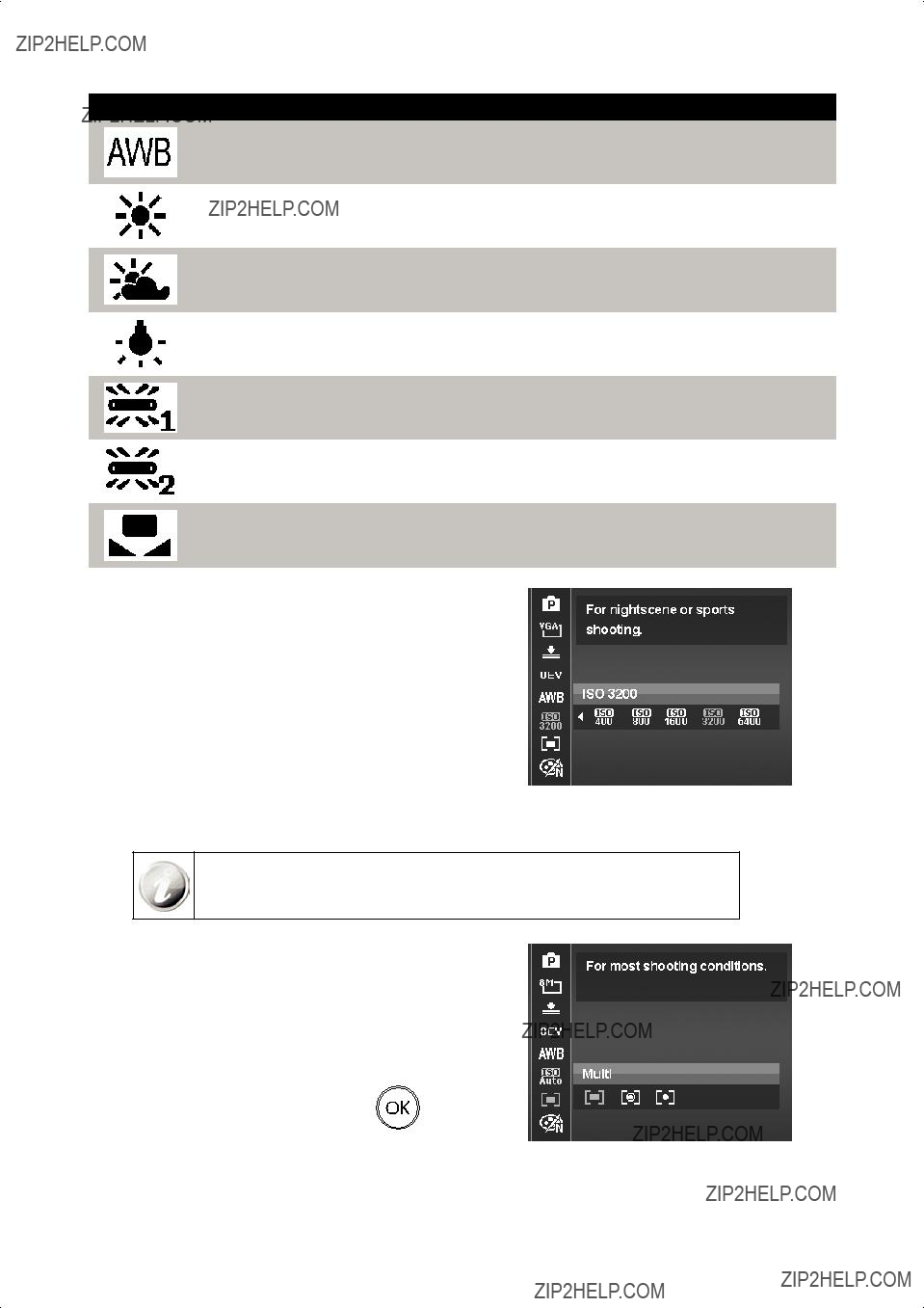
ISO
This sets the sensitivity of the sensor for capturing photos to compensate for various lighting situations. When the sensitivity is raised (and the ISO value is increased), photography in dark or dim lit locations are improved. However, this may result in a more pixelated (grainier) photo.
???Use a higher ISO setting in dim conditions and a lower ISO setting in brighter conditions. Read the text at the top to assist in determining the desired result.
???Available settings are: Auto, 100, 200, 400, 800, 1600, 3200 <3M>, 6400 <3M>.
If the Stabilizer is enabled, ISO is automatically set to Auto and cannot be adjusted.
To adjust ISO disable Stabilizer first.
Metering
The Metering function allows adjustment to select the area of the subject or frame by which the camera measures light to record still images or video.
???As adjustments to the settings are made, the LCD screen synchronously displays the image applying the
???Below is a table with a description of the different settings.
28

Color Mode
This feature allows adjustment to record photos and videos in different colors and tones for a more artistic effect. Tinting an photo or video color can make them appear more vivid.
???As adjustments to the settings are made, the LCD screen synchronously displays the image applying the Color
??? Below is a table with a description of the different settings.
29
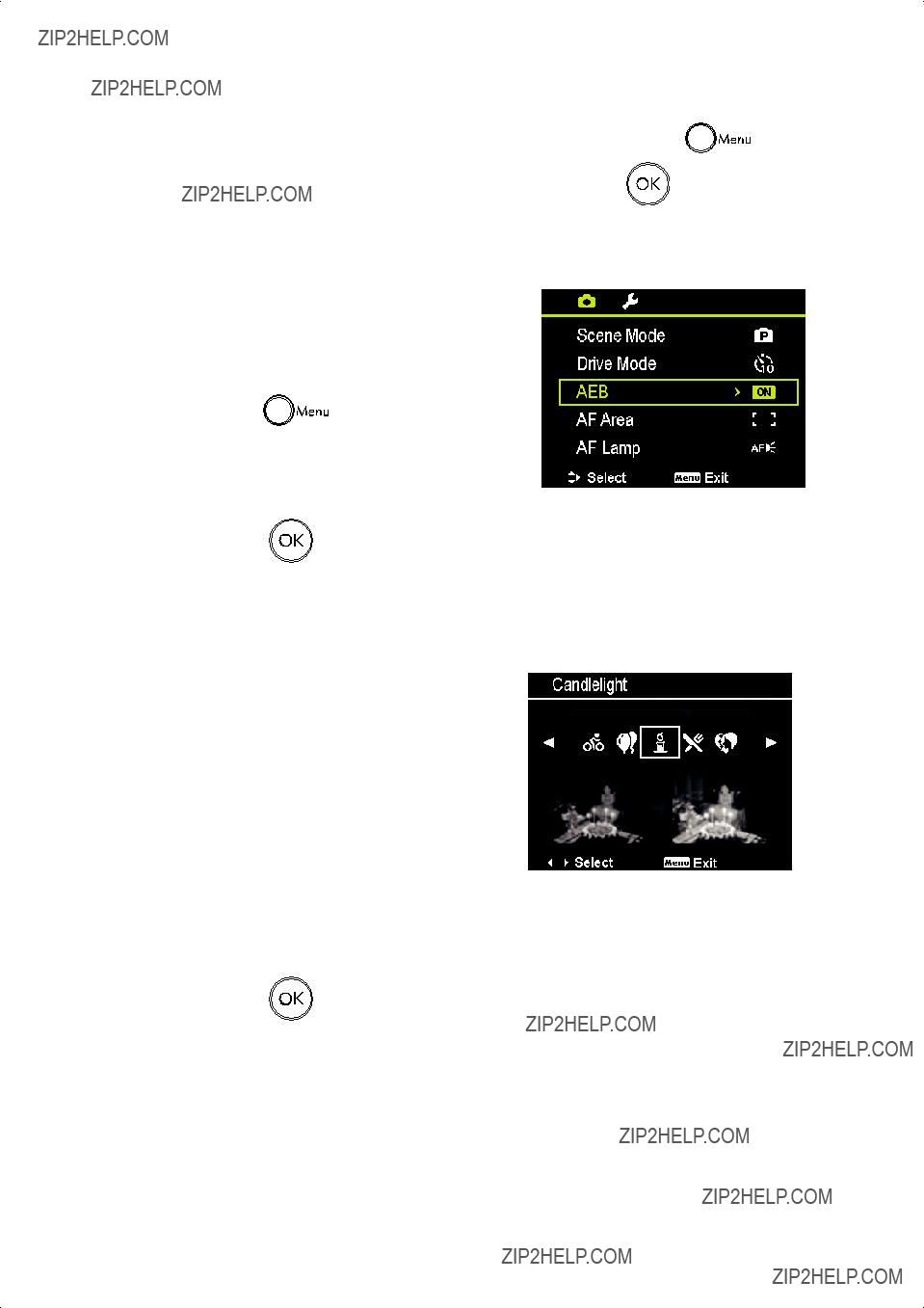
Using the Record Menu
selections and apply the desired settings. To close the menu anytime, press the menu button again.
Record Menu
The Record menu allows changes to the scene modes, and setup other capture settings.
To go to Record Menu:
Set the mode switch Photo Mode [  ].
].
2.Use the 

 or
or 
 keys to move through the menu
keys to move through the menu
3.To select an item, press  .
.
4.Change the submenu settings using the
Setting the Scene Mode
This camera offers 34 different modes, that can assist in taking a photo with the optimal settings or desired effects.
1.From the Record Menu, enter the Scene Mode options menu.
2.Use the left and right navigation controls to move through the selections.
3.The highlighted scene mode will either have text that describes the benefits of the mode or have a
4. Press the OK button to save and activate the selected scene mode.
5.It is important to return the camera to the Auto mode when finished shooting specifics conditions. This will reduce the risk of taking a bad photo in normal situations. If the camera is powered off and then powered on, it will return to Auto scene mode be default.
30
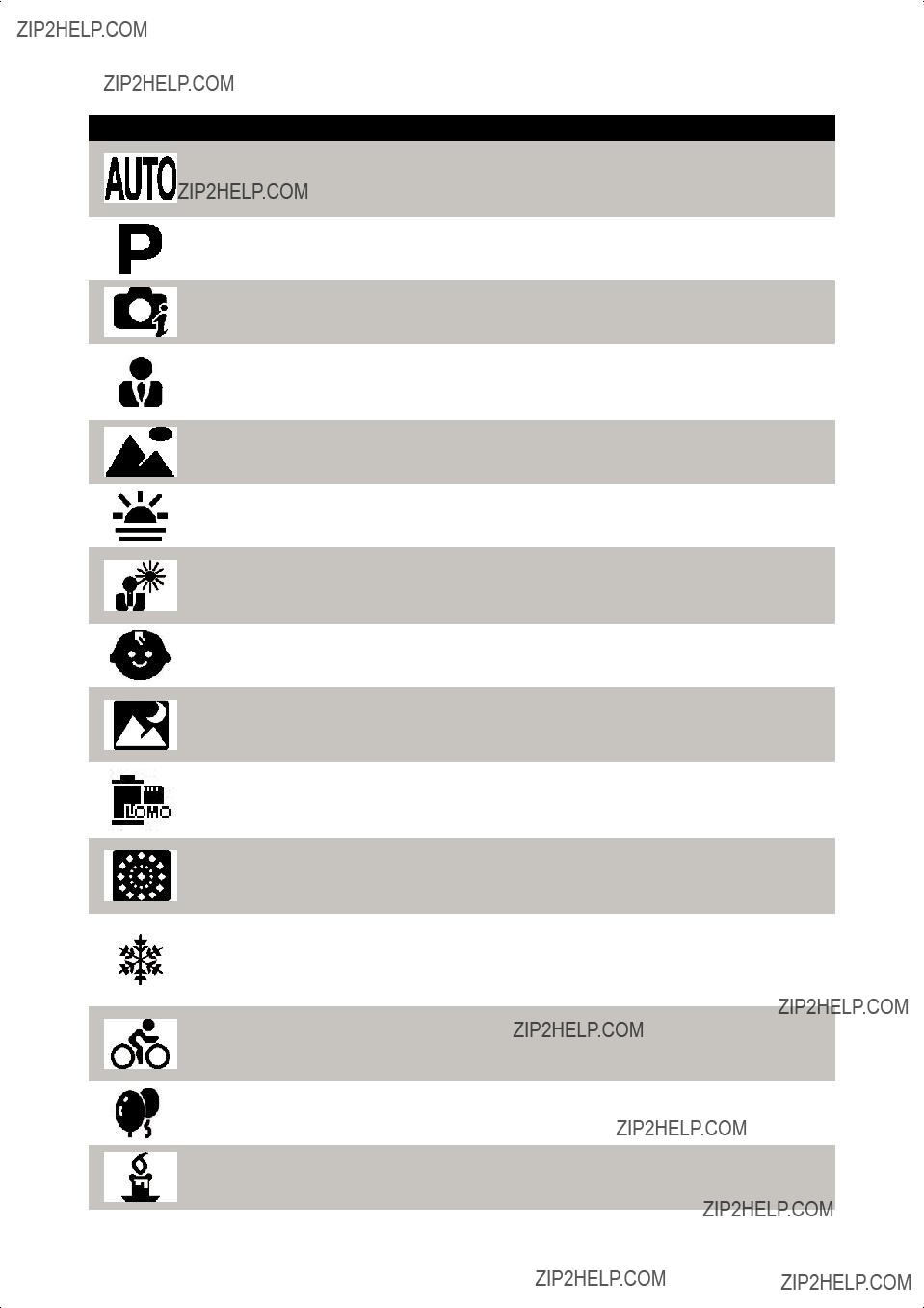
The table below shows the available scene mode settings:
31

32

After selecting the scene mode, the selected mode, except Voice Rec, will be added to the forefront in My Mode of Function Menu.
33

Using Intelligent Scene
This feature is most useful for novice users to capture great images even without basic knowledge of photography. Simply frame the shot with the help of Intelligent Scene Mode, the camera automatically recognizes 11 kinds of scenes - Portrait, Landscape, Sunset, Macro, Text, Snow, Backlight Portrait, Backlight Portrait, Night Scene, Night Portrait and Foliage - and selects the ideal settings.
Intelligent scene icon. After the camera detects the shooting conditions, this icon changes to show the detected scene mode.
1.Select  from the Scene Mode submenu.
from the Scene Mode submenu.
2.Focus the camera on the subject to capture.
3.The camera detects the shooting conditions and switches to an appropriate scene mode.
4.Half press the Shutter button to focus the subject. The frame turns green to indicate focus is set.
5.Press the Shutter button to take the shot.
Using Kids Mode
Many people believe kids are on of the most difficult subject to photograph. They tend to be highly animated and can be a real challenge to make them pay attention for more than just a second or two. To capture a great moment for your kids, just keep the camera in kid mode. The mode provides higher shutter speed and always focuses on moving subject.
34
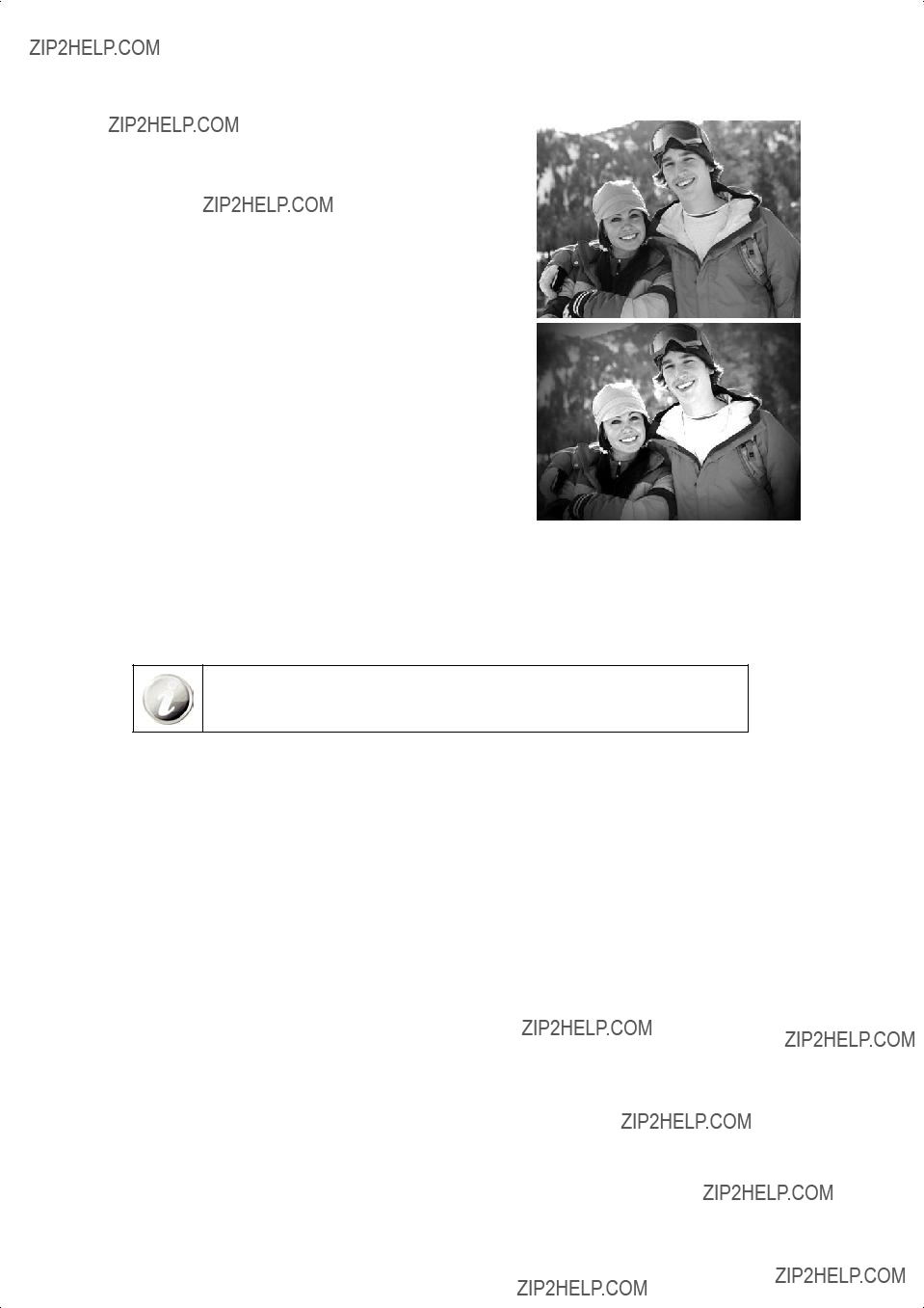
Using LOMO Mode
The LOMO mode applies the following effects on the photo:
1.
2.
3.Blurring
4.Darkening around the edges of photo
Using Sports Mode
Ideal to taking a series of sports motion images, such as a golf swing, or try to capture the images of a flying hummingbird/butterfly, be sure to switch the scene mode to sports mode. This mode provides shutter in Burst speed (Keep shooting images long as the Shutter button is pressed) which allows you to capture a sequence of pictures that are frames apart clearly.
Make sure to have plenty of capacity on the memory card as it will be needed.
Using Party Mode
Let the Party begin! It can be difficult to get everyone on a party. Get the whole gang together, take a group or family portrait. Party mode features
Using Soft Skin mode
When the soft skin mode is activated, it makes wrinkles and lines look less conspicuous, while preserving resolution in areas of the picture outside of the skin. The camera detects skin color area, such as the face and processes the image to make the skin appear smooth.
35
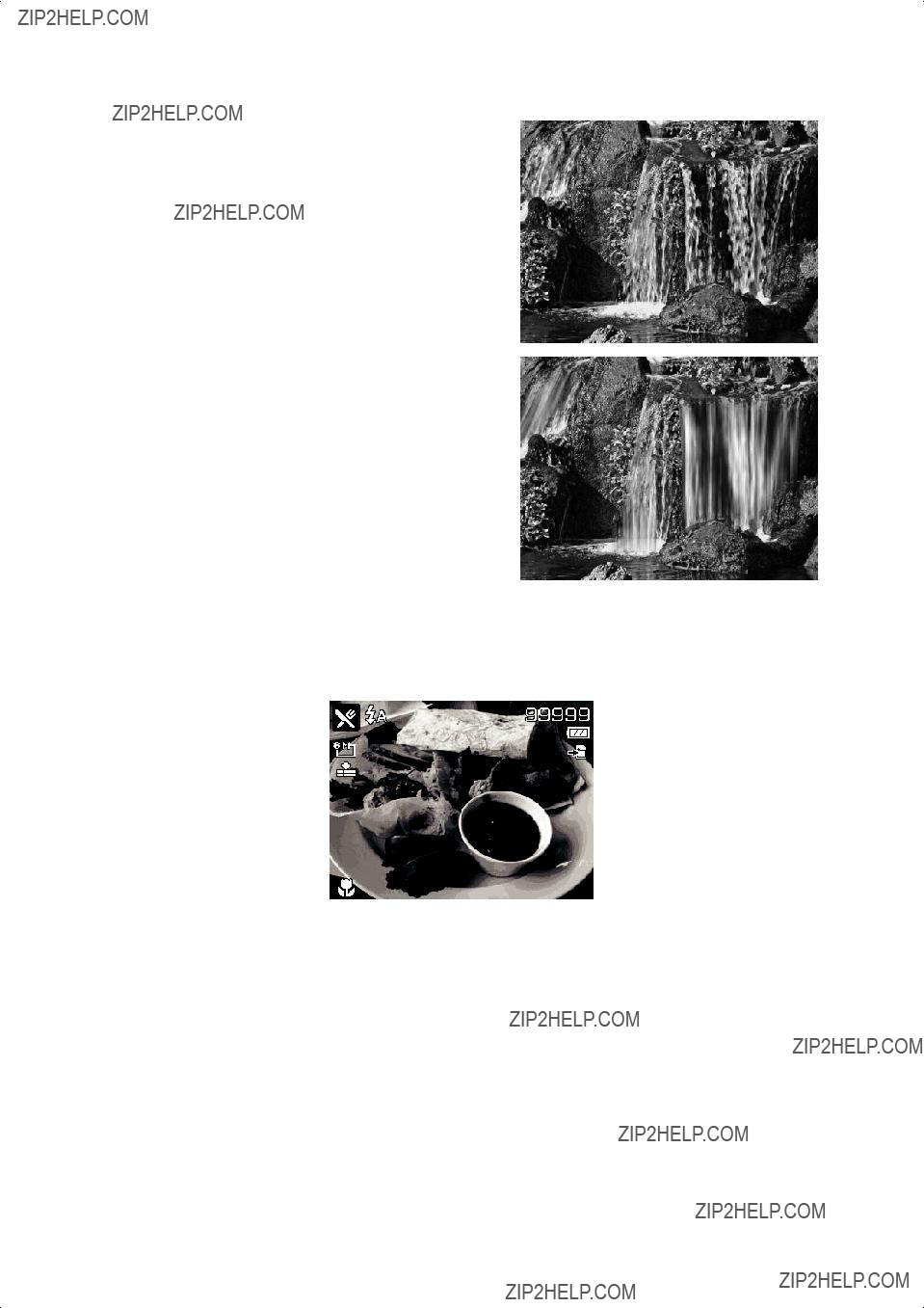
Using Flowing water
Select this mode to enhance flowing water by applying a slight blurring effect.
Using Food Mode
How to share your dining experiences and comments of interesting widgets on your blog by
Using Foliage Mode
A scenic image, such as a garden or forest scene, that full of doll green colors is boring. In foliage mode, the greens, blues, are brilliantly enhanced making scenic pictures pop out with bright color.
Using Auction Mode
It???s hard and wastes a lot of time to combine several images by software. Select Auction mode and choose a pattern, then take a few shots from different angle. The camera composes a combined image in lower resolution suited to online posting.
36
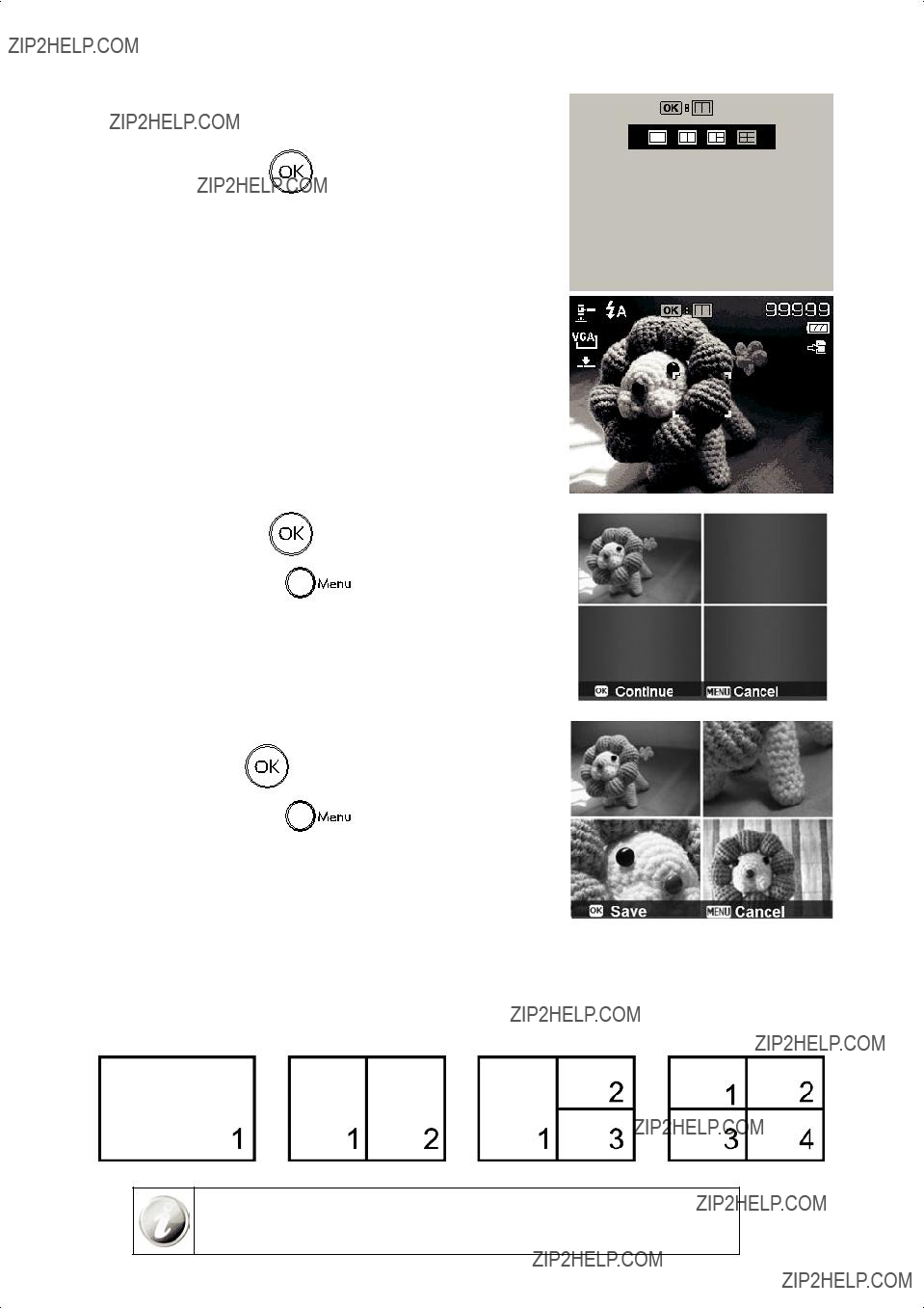
1.Select Auction mode from Scene mode menu.
2.Use 
 or
or  keys to choose a pattern.
keys to choose a pattern.
4.Frame the subject and press the Shutter button  to take the first shot.
to take the first shot.
7.Repeat step 4 to 6, until the pattern is filled in images.
8.Press OK button to save the composed image.
10.The camera save the image to memory.
11.Use USB cable or memory card reader (Please refer to ???Connecting the Camera to a PC??? on page 69) to transfer the image to PC and upload it to website.
Auction mode provides 4 kinds of pattern as follow
The end photo is set to low quality and VGA (640x480) size only for the purposes of having a small files size easy for uploading.
37

Using Smile Capture Mode
When facing the camera, especially kids, smiles are always short and hard to seize by manual shutter. Smile capture mode detects every smile all the time and performs Automatic Focus (AF) to capture an image without pressing Shutter button.
Follow these instructions to capture a photo by Smile Capture
Mode:
1.Select  from scene menu.
from scene menu.
2.Focus the camera on the subject to capture.
3.When a smile is detected, the white focus frame turns green to denote camera shutter and take a shot automatically.
Using Blink Detection Mode
Nothing ruins a great picture more than having a subjects??? eyes closed. Blink Detection provides an extra assurance when capturing
If closed eyes are detected, a saving confirmation menu appears on the screen, allowing for a
To activate Blink Detection
1.Select  from Scene Mode submenu.
from Scene Mode submenu.
2.Half press the Shutter button  to focus the subject. The frame turns green to indicate focus is set.
to focus the subject. The frame turns green to indicate focus is set.
3.Press the Shutter button  to capture the photo and automatically save the Image.
to capture the photo and automatically save the Image.
4.If the camera detects that a subject has blinked, a ???Save image or Cancel??? option appears on the screen.
5.Select Save image to save the photo, or Cancel to disregard.
Using
When asking someone else to take photos for you, but the photos always don???t come up right?
Basically,
1.Compose the desired background and press the
Shutter button  (full press), which causes a
(full press), which causes a
Menu button  to cancel the
to cancel the
38

2.Ask someone else to take the desired picture by using the
3.Move your position until photographer confirm your whole or half body in the frame and in the right place.
4.Press the Shutter button. Camera stores the image produced by this step only.
Using Love Portrait
Want to take a good photo when there are just two of you? All you have to do is position the camera and smile together.
If two or more faces are recognized, the camera performs  .
.
Using Self Portrait
When taking the picture for yourself, the self portrait mode is necessary besides the tripod. If a face has been recognized, the camera performs
Shutter button  .
.
Tips to make a great shape by self portrait photography:
???Lean in towards the camera to reduce double chin.
???Angle your body and bend your arms to look slimmer.
???Keep your shoulders back.
Using HDR Mode
Active HDR mode preserves details in highlights and shadows, creating photos with natural contrast. Use for high contrast scenes, for example, when photographing brightly light outdoor scenery through a door/window, or taking pictures of shaded subjects on a sunny day. With this feature, the adjustment of contrast is accomplished
39

Using Fisheye Lens Mode
The Fisheye Lens mode applies a hemispherical effect on the photos to make them look more interesting.
Using Aperture Priority Mode
This mode is designed for control the aperture value by user and let camera decide the shatter speed. The main impact that aperture had on images was with regards to Depth of Field. (DOF)
???Choose lager aperture, only one subject in focus but the background nice and blurred. (Shallow DOF)
???Choose smaller aperture, an image with everything in focus. (Great DOF)
To set Aperture values
1. Select  from the Scene Mode submenu.
from the Scene Mode submenu.
3.Use the 

 or
or 
 keys to select the aperture value options.
keys to select the aperture value options.
4.Press the Shutter button  to capture the image.
to capture the image.
Displays the aperture value
Using Shutter Priority Mode
This mode is designed for capturing moving subjects. A faster shutter speed is required to freeze a motion (flying birds), while the slower shutter speed creates a sense of motion (water flowing).
To set Shutter values
1. Select  from the Scene Mode submenu.
from the Scene Mode submenu.
3.Use the 
 or
or  keys to select the shutter value options.
keys to select the shutter value options.
4.Press the Shutter button  to capture the image.
to capture the image.
Displays the shutter value
40

Using Manual Exposure
When the camera is in the manual exposure mode, you can change either aperture or shutter speed, or both.
To activate Manual Exposure
1. Select  from the Scene Mode submenu.
from the Scene Mode submenu.
3.Use the 
 or
or  keys to select the shutter speed.
keys to select the shutter speed.
4.Or, use the 

 or
or 
 keys to select the aperture value.
keys to select the aperture value.
5. Use the OK button to switch between aperture and shutter speed adjustment and vice versa.
6. Press the Shutter button  to capture the image.
to capture the image.
Displays the aperture and shutter speed value
Using Voice Recording
1.From the Scene menu, select  . The Voice Recording screen layout is displayed on the LCD monitor.
. The Voice Recording screen layout is displayed on the LCD monitor.
2.Press the Shutter button  to start recording.
to start recording.
3.Press the Shutter button  again to stop recording.
again to stop recording.
Setting the Drive Mode
This camera features a
To set the Drive Mode
1.From the Record menu, select Drive Mode.
2.Use the 

 or
or 
 keys to go through the selection.
keys to go through the selection.
The table below shows the available Drive mode settings.
41

Setting the AEB
AAEB stands for Automatic Exposure Bracketing. It takes 3 consecutive photos in the order of standard exposure, under exposure and overexposure compensation.
To set AEB
1.From the Record menu, select AEB.
2.Use the 
 or
or 

 keys to go through the selection.
keys to go through the selection.
Setting the AF Area
AF stands for Automatic Focus. This feature determines the area on which the camera focuses.
To set AF Area
1.From the Record menu, select AF Area.
2.Use the 
 or
or 

 keys to go through the selection.
keys to go through the selection.
42

The table below shows the available AF area settings.
Setting the AF Lamp
The AF Lamp function allows you to record images even low light conditions.
If AF Lamp is set to Auto, the AF lamp located in the front of the camera, see ???Front View??? on page 9, emits an red light by half pressing the Shutter button allowing the camera to focus easily.
To set AF Lamp
1.From the Record menu, select AF Lamp.
2.Use the 

 or
or 
 keys to go through the selection.
keys to go through the selection.
Setting Sharpness
This function allows you to enhance or soften finer details of your photos.
To set Sharpness
1.From the Record menu, select Sharpness.
2.Use the 

 or
or 
 keys to go through the selection.
keys to go through the selection.
The table below shows the available Sharpness settings:
43

Setting Saturation
The Saturation function lets you adjust the color saturation in your photos. Use a higher saturation setting for rich colors and a lower saturation setting for more natural tones.
To set Saturation
1.From the Record menu, select Saturation.
2.Use the 

 or
or 
 keys to go through the selection.
keys to go through the selection.
3.Press the OK button  to save and apply changes.
to save and apply changes.
The table below shows the available Saturation settings.
Setting Contrast
This function allows you to adjust the contrast of your photos.
To set Contrast
1.From the Record menu, select Contrast.
2.Use the 

 or
or 
 keys to go through the selection.
keys to go through the selection.
44

Setting the Digital Zoom
This feature controls the digital zoom mode of your camera.
Your camera enlarges an image using the optical zoom first. When the zoom scale exceeds 4x, the camera uses digital zoom.
To set Digital Zoom
1.From the Record menu, select Digital Zoom.
2.Use the 

 or
or 
 keys to go through the selection.
keys to go through the selection.
3.Press the OK button  to save and apply changes. The table below shows the available Digital Zoom settings.
to save and apply changes. The table below shows the available Digital Zoom settings.
???Digital Zoom is not available in Smile Capture, Movie, and Voice Recording modes.
???The maximum Intellect zoom scale varies depending on the image type and resolution.
Setting the Date Stamp
The date of recording can be printed directly on the still images. This function must be activated before the image is captured. Once date and time are stamped on a photo, they can no longer be edited or deleted.
Limitations of Date Stamp functions are as follows:
???Available for Photos only.
???May slow down AEB/ Burst mode when Date Stamp is enabled in AEB/ Burst mode.
???In vertical or rotated images, the date and time on your photos still appear horizontally.
To set Date Stamp
1.From the Record menu, select Date Stamp.
2.Use the 

 or
or 
 keys to go through the selection.
keys to go through the selection.
45
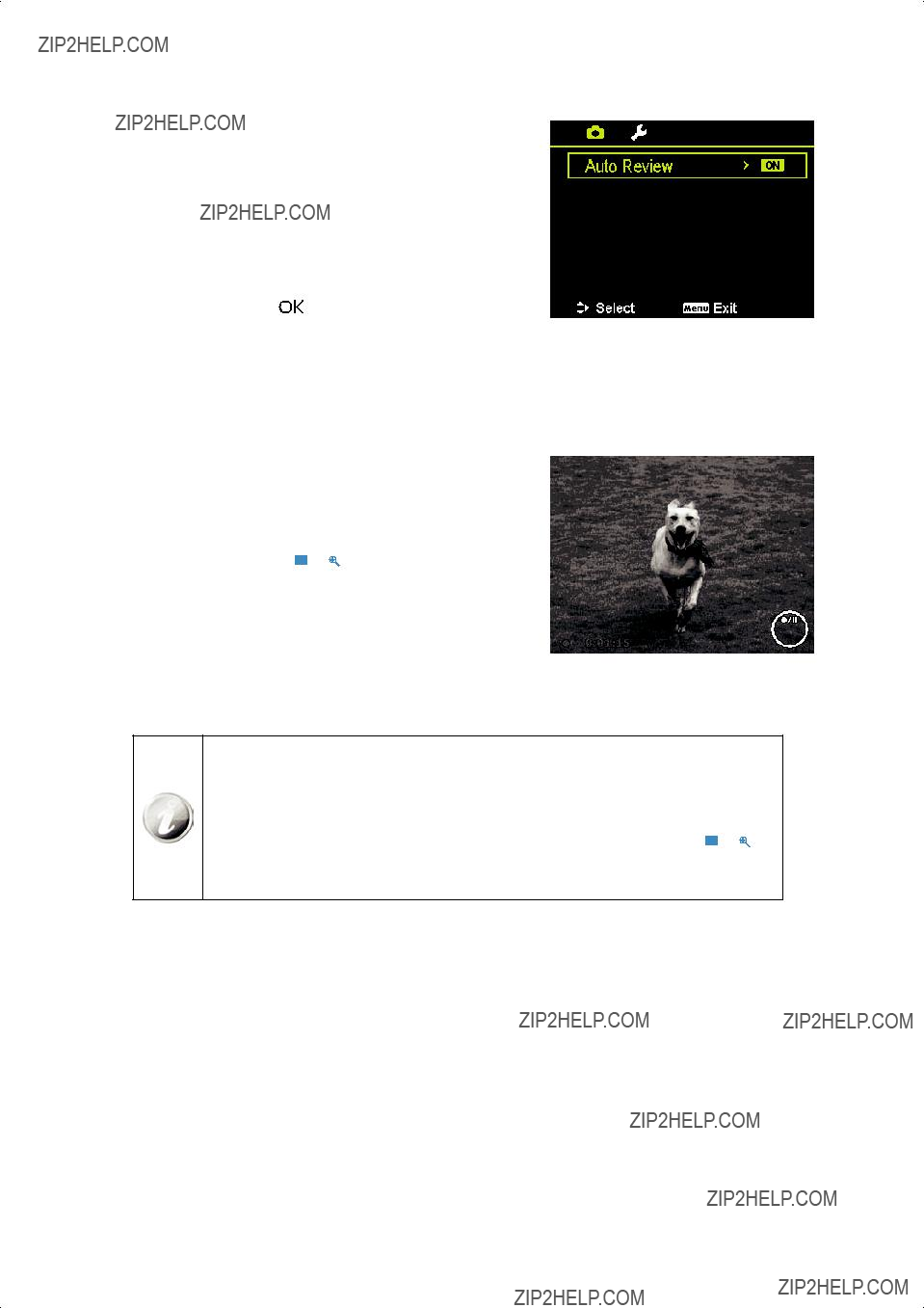
Setting Auto Review
The Auto Review function lets you view the captured image right after shooting it.
If Auto review is On, the camera will display the captured image for 1 second on the LCD monitor.
To set Auto Review
1.From the Record menu, select Auto Review.
2.Use the 

 or
or 
 keys to go through the selection.
keys to go through the selection.
3.Press the OK button  to save and apply changes.
to save and apply changes.
Recording Videos
Record videos with the camera, the available recording time depends on the capacity of the memory card. Videos can be recorded until the maximum memory capacity has been reached. However the length of a single video may be limited (the limitation depends on the camera model).
1.Slide the Mode switch to Video mode  .
.
2.Focus your camera on the subject that you want to take.
3.Press the Shutter button  to start recording.
to start recording.
4.Use the Zoom buttons  to zoom in and zoom out an image.
to zoom in and zoom out an image.
5.To pause recording, press the key 

 .
.
6.To continue recording, press the key 

 again.
again.
7.To stop recording, press the Shutter button  .
.
???When the camera stop recording due to reaching maximum capacity (4GB) for a single video, simply press the Shutter button again to continue recording.
???The camera will automatically stop recording when the memory capacity is full.
???Digital zoom is not available while recording a movie.
???Sound cannot be recorded while using zooms (Pressing the Zoom buttons  ).
).
???Power save is not available in movie recording or pause recording.
46
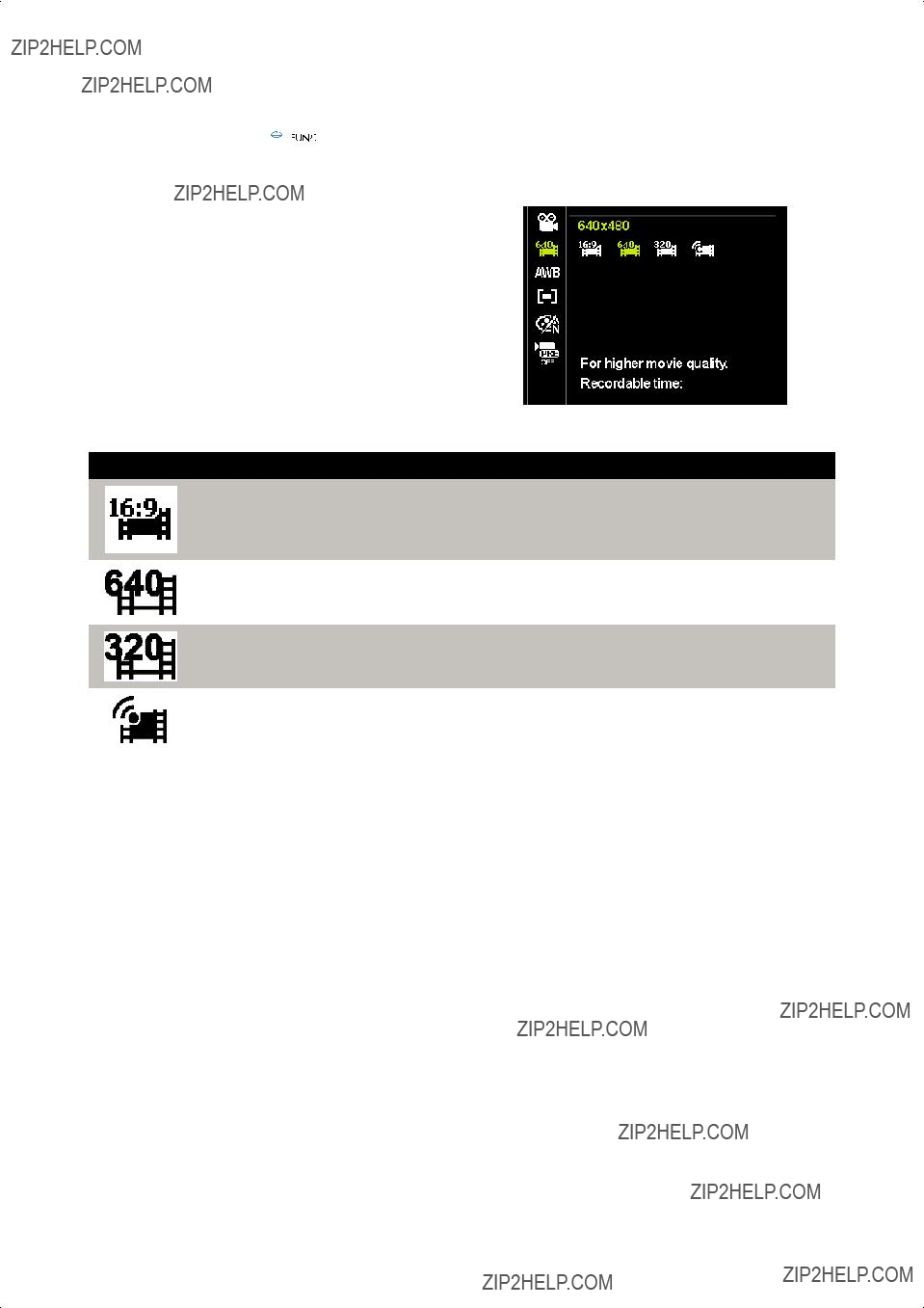
Settings of Recording Videos
Press Function button 
 to enable video setting menu before recording a video.
to enable video setting menu before recording a video.
Video Size
The Video Size function appears only in Video mode. Use this function to adjust the resolution and quality of video clips.
The table below shows the available size and corresponding image quality settings:
Internet Mode
The Internet Mode will record videos with predefined settings for easy upload to the Internet website.
The Internet supports two file upload standards:
???Single File Uploader. The maximum movie file size is up to 100 MB.
???Internet Uploader. The maximum movie file size is up to 1 GB.
Most uploaded movie length ranges within 5 minutes.
Therefore when recording in YouTube mode, the following standards are followed:
???Recorded movies are set to Internet standard resolution of 640 X 480.
???Recording automatically stops when the file reaches 100 MB.
???To record a YouTube movie, select from the Movie Size function. Available recording time for a YouTube movie is up to 10 minutes.
47

White Balance, Metering, Color Mode
To set above settings, please refer to ???Using the Function Menu??? on page 26.
Catch the first three seconds of action that may would have potentially missed. Once enable this function, the camera starts recording movie automatically before pressing Shutter button. As soon as the Shutter button is hit, the most recent three seconds of video are added to the beginning of the clip.
Display the icon in red while turning
???After recording starts.
???Switch to Photo mode or Playback mode.
???Any kind of menu is turned on.
???Enter USB mode.
48

Playback
Playback the still images, video and audio clips on the LCD screen.
Viewing in Single Navigation
The Single navigation mode displays the image one by one on the LCD monitor. To view images/videos/audio clips, follow the steps below.
1.Slide the Mode switch to Playback mode  .
.
2.The LCD monitor displays an image. To understand the icons and other information on the screen, please see ???Photo Mode Screen Layout??? on page 14.
3. Use the 
 or
or  keys to view next/previous image/video/audio.
keys to view next/previous image/video/audio.
Viewing Thumbnails
This feature will display
To set
1.Set the camera to Playback mode  .
.
2.Press the  button once to enter
button once to enter
3.Use the navigation controls to move through the items.
Scroll bar.
If scroll bars appear, it indicates that the screen can be scrolled.
49

To set calendar mode
1.Set the camera to Playback mode  .
.
2.Press the  button twice to view thumbnails in calendar mode.
button twice to view thumbnails in calendar mode.
3.Use the navigation controls to move through the items.
In calendar mode:
???The ???rst ???le (Including photo, video, audio and error ???le) recorded on each date appears on the screen.
???Press the  button would back to
button would back to
Thumbnail icons:
Thumbnails images may contain icons. These icons indicate the type of file or recording:
Zooming images
The zoom view function works with Photos only.
???In normal view, press the  button repeatedly until the desired zoom view.
button repeatedly until the desired zoom view.
???The 4 arrows on the LCD monitor indicate that the image is zoomed in.
???Zoom to view a Photo of up to 12X.
???Use the navigation controls to view the zoomed photo.
For 320 x 240 resolution photos, they can only zoom in up to 6X.
50

Playing Videos
1.Set the camera to Playback mode  .
.
2.Use the navigation controls to scroll through the saved images. A movie clip has a movie icon displayed on screen.
4.During playback, press and hold the 
 or
or  keys to fast forward or rewind the movie. The camera supports forward and rewind speed of up to 4x.
keys to fast forward or rewind the movie. The camera supports forward and rewind speed of up to 4x.
5.During playback, use the Zoom buttons  to control volume. Press the
to control volume. Press the  button to increase volume/Press the
button to increase volume/Press the  button to decrease volume.
button to decrease volume.
6.Press the 

 key to pause playback. Press the key
key to pause playback. Press the key 

 again to resume. When paused, the play info will remain on screen except
again to resume. When paused, the play info will remain on screen except 
 .
.
7.To forward or rewind the video frame by frame, press the key 

 to pause playback, then press the
to pause playback, then press the 
 or
or  keys.
keys.
8.Press the 
 key to stop the playback. The LCD monitor displays the movie frame image in Single navigation mode.
key to stop the playback. The LCD monitor displays the movie frame image in Single navigation mode.
???The play info, except the icon 
 , will be displayed when the movie is paused, during REW/FF or frame by frame modes
, will be displayed when the movie is paused, during REW/FF or frame by frame modes
???Volume cannot be adjusted when paused or during REW/FF modes.
To capture screenshot image from a movie clip
1.During playback of movie, press the key 

 to pause playback on your desired movie frame to capture.
to pause playback on your desired movie frame to capture.
2.Press the Shutter button  to capture a screenshot.
to capture a screenshot.
3.The camera will automatically stop playback. The LCD monitor displays the captured photo in Single navigation mode.
This feature does not function when the memory card is full or the folder cannot be created. The icon  does not appear on the screen either.
does not appear on the screen either.
51

Playing Voice Recording
1.Set the camera to Playback mode  .
.
2.Use the navigation controls to scroll through the saved images. When viewing a voice recording file, the LCD monitor displays the screen layout of Audio clips. See picture on the right.
4.During playback, use the Zoom buttons  to control volume. Press the
to control volume. Press the  button to increase volume/Press the
button to increase volume/Press the  button to decrease volume.
button to decrease volume.
5.Press the 

 key to pause playback. Press the
key to pause playback. Press the 

 key again to resume. When paused, the play info will remain on screen except
key again to resume. When paused, the play info will remain on screen except 
 .
.
6.Press the 
 key to stop the playback. The LCD monitor displays the image in Single navigation mode.
key to stop the playback. The LCD monitor displays the image in Single navigation mode.
Volume cannot be adjusted during Pause or REW/FF modes.
Playing Voice Memo
Voice memo is separately recorded and attached to a captured image. See "Voice Memo" on page 56 on how to record voice memo.
1.Set the camera to Playback mode  .
.
2.Use the navigation controls to scroll through the saved images. An image file with voice memo has a voice memo icon located on the top center of the LCD monitor. See picture on the right.
4.During playback, use the Zoom buttons  to control volume. Press the
to control volume. Press the  button to increase volume/Press the
button to increase volume/Press the  button to decrease volume.
button to decrease volume.
5.Press the key 

 to pause playback. Press the key
to pause playback. Press the key 

 again to resume. When paused, the play info will remain on screen except
again to resume. When paused, the play info will remain on screen except 
 .
.
6.Press the key 
 to stop the playback. The LCD monitor displays the image in Single navigation mode.
to stop the playback. The LCD monitor displays the image in Single navigation mode.
Volume cannot be adjusted when you pause the voice memo.
Deleting an Image/Video/Audio
There are two ways to delete an image/video/audio:
???Using the Delete button.
???Using Playback Menu Delete settings. See ???Delete??? on page 53.
52

Using the Delete Button
Use the Fn/Delete button on your camera to delete or mark an image/video/audio clip for deletion.
1.Set the camera to Playback mode  .
.
2.View images/videos/audio clips in Single navigation mode.
3.Use the 
 or
or  keys to scroll the display.
keys to scroll the display.
4.When the desired image/video/audio clip is displayed on the LCD monitor, press the Fn/Delete 


 button.
button.
5.A confirmation selection appears on screen.
6.Select Delete.
8.The next image is displayed on the LCD monitor. To delete another file, use the 
 or
or  keys to scroll through the images/videos/audio clips. Then, repeat steps 5 to 7.
keys to scroll through the images/videos/audio clips. Then, repeat steps 5 to 7.
9.To close the Delete function and go back to the single navigation mode, select Cancel.
Locked files cannot be deleted at any time. When you try to delete a locked file, the camera displays ???File Locked??? message on the LCD monitor.
Playback Menu
The Playback menu allows you to edit images, record voice memo, and setup playback settings.
To go to Playback Menu:
1. Slide the mode switch to Playback mode  .
.
5. Change the submenu settings using the
Slideshow
The slideshow function enables you to playback your still images automatically in order one image at a time.
To view slideshow:
1.From the Playback menu, select Slideshow. The Slideshow menu appears.
2.Set the slideshow settings.
53
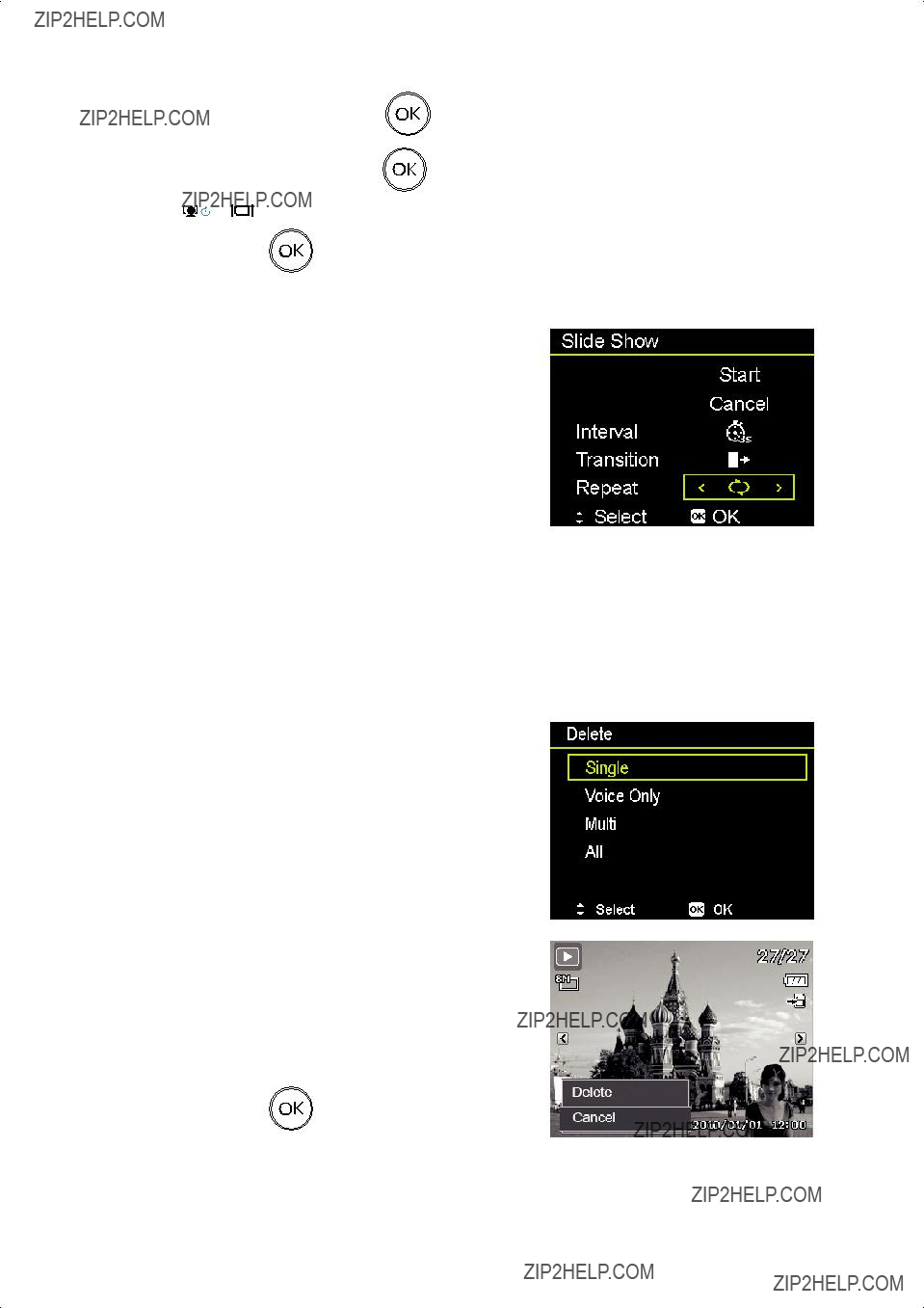
To change slideshow settings:
1.From the Slideshow menu, use the 

 or
or 
 keys to move through the selections.
keys to move through the selections.
2.Select Interval setting. Press the 
 or
or  keys to adjust. Choose among the available interval settings: 1 sec., 3 sec., 5 sec., and 10 sec.
keys to adjust. Choose among the available interval settings: 1 sec., 3 sec., 5 sec., and 10 sec.
3.Select Transition setting. Press the 
 or
or  keys to adjust. Choose among the available transition settings:
keys to adjust. Choose among the available transition settings:
???Horizontal
???Shrink
???Fade
???Random
4.Select Repeat setting. Press the 
 or
or  keys to adjust. Available settings are: Yes, No.
keys to adjust. Available settings are: Yes, No.
Delete
The Delete function allows to remove unwanted files in the internal memory or on the memory card. Protected files cannot be erased, to delete, unprotect the file first. See ???Protect??? on page 55.
To delete a image/video/audio clip:
1.From the Playback menu, select Delete.
2.The Delete submenu is displayed on the LCD monitor. Available select settings:
???Single. Select one file to delete.
???Voice Only. Delete only the attached voice memo, not voice clips. The image is still retained in the memory.
???Multi. Select multiple files to delete at the same time.
???All. Delete all files.
To delete a single ???le:
1.Select Single in the Delete submenu, the images are displayed on the LCD monitor in single navigation mode.
2.Use the 
 or
or  keys to scroll the display.
keys to scroll the display.
3.When the desired image/video/audio clip is displayed on the LCD monitor, select Delete.
5.The next image is displayed on the LCD monitor. To delete another file, use the 
 or
or  keys to scroll through the images/videos/audio clips. Repeat steps 3 to 4.
keys to scroll through the images/videos/audio clips. Repeat steps 3 to 4.
6.To close the Delete function and go back Playback menu, select Cancel.
54

To delete attached voice memo:
1.Set the camera to Playback mode  .
.
2.View images/videos/audio clips in Single navigation mode.
3.Use the 
 or
or  keys to scroll until the desired image with voice memo is displayed on the screen.
keys to scroll until the desired image with voice memo is displayed on the screen.
5.Use the 

 or
or 
 keys to move through the Playback menu selections then select Delete.
keys to move through the Playback menu selections then select Delete.
6.From the Delete submenu, select Voice only.
7.A confirmation selection appears, select Delete.
8.Press the OK button to delete the attached voice memo and go back to Playback mode.
The Voice Memo submenu is disabled if the current image displayed, at the time you access the Delete menu, does not have any attached voice memo.
To delete multiple ???les:
1.Select Multi in the Delete submenu, the images are displayed in thumbnail view on the LCD monitor.
2.Use the navigation control to move through the files.
3.When the desired image/video/audio clip is highlighted, press
the OK button to mark image/video/audio clip for deletion.
4.Repeat step 3 until all desired images for deletion are marked.
To delete all ???les:
1.Select All in the Delete submenu. A confirmation message appears.
2.Select Yes.
55

Protect
Set the data to  when viewed on Playback mode.
when viewed on Playback mode.
To protect ???les:
1.From the Playback menu, select Protect.
2.The Protect submenu is displayed on the LCD monitor. Available select settings:
???Single. Select one file to lock.
???Multi. Select multiple files from the thumbnail view to lock.
???Lock All. Lock all files
???Unlock All. Unlock all files.
To protect/unprotect a single ???le:
1.Select Single in the Protect submenu, the images are displayed on the LCD monitor in single navigation mode.
2.Use 

 or
or 
 keys to scroll the display.
keys to scroll the display.
3.When the desired file is displayed on the LCD monitor, select
Lock/Unlock.
To protect/unprotect multiple ???les:
1.Select Multi in the Protect submenu, the images are displayed in thumbnail view on the LCD monitor.
2.Use the navigation control to move through the files.
3.When the desired file is highlighted, press the OK button
to mark/unmark the file clip for protection.
4. Repeat step 3 until all desired files to protect are marked.
56

To protect all ???les:
1.Select Lock all in the Protect submenu. A confirmation message appears.
2.Select Yes.
To unlock all ???les:
1.Select Unlock all in the Protect submenu. A confirmation message appears.
2.Select Yes.
The
To activate
1.Set the camera to Playback mode  .
.
2.Press the 
 or
or  keys to scroll and select an image.
keys to scroll and select an image.
4.Select
5.Select Start.
7.After completing
???Overwrite. Save and replace old file with a new one.
???Save As. Save the new file as a new one.
???Cancel. Cancel
Voice Memo
A maximum of 30 seconds of audio can be recorded as a memo for captured still images.
To record voice memo:
1.Set the camera to Playback mode  .
.
2.Press the 
 or
or  keys to scroll and select an image to attach voice memo to.
keys to scroll and select an image to attach voice memo to.
57

Time left (n seconds) for recording.
When recording a voice memo to an image with an existing voice memo, the old recording file would be replaced by the new one.
Color Mode
The Color Mode function lets you adjust edit still images to apply different colors or tones for a more artistic effect. Edited photos in this function are saved as a new file.
To activate Color Mode:
1.Set the camera to Playback mode  .
.
2.Press the 
 or
or  keys to scroll and select an image to edit.
keys to scroll and select an image to edit.
5.Press the 
 or
or  keys to scroll and select an option. As you move through the selection, the preview on the LCD monitor changes synchronously.
keys to scroll and select an option. As you move through the selection, the preview on the LCD monitor changes synchronously.
58

The succeeding table shows the available settings.
59

Trim
The Trim function allows you to trim an image to another image size. This function is only available for still images.
To trim an image:
1.Set the camera to Playback mode.
2.Use the 
 or
or  keys to scroll and select an image to trim.
keys to scroll and select an image to trim.
4.Select Trim. The Trim screen layout is displayed on the LCD monitor.
5.Use the Zoom buttons  to change size as zoom in/out.
to change size as zoom in/out.
No. Description
1 Enlarged image
2
3Trimmed size
4 The approx. location of the trimmed area
5Image area
6.Use the navigation controls to move the image.
7.Press the OK button to apply changes. A menu selection appears.
8.Select whether to:
???Overwrite. Save and replace the old file with the new one.
???Save As. Save the new file as a new one.
???Cancel. Cancel resize.
???Trim function is not available for photos with image size set to VGA.
???All images will be trimmed in 4:3 ratio regardless of its original image ratio.
60

Resize
Resizes a previously saved image and only resizing to a smaller size is available.
To resize an image:
1.Set the camera to Playback mode  .
.
2.Use the 
 or
or  keys to scroll and select an image to resize.
keys to scroll and select an image to resize.
4.Select Resize. The Resize submenu is displayed on the LCD monitor.
5.Select size among: 8M, 5M, 3M, and VGA. Available size settings may vary depending on original image size. Unavailable settings appear as gray icons in Resize submenu.
6.After selecting size, a menu selection appears. Select whether to:
???Overwrite. Save and replace old file with a new one.
???Save As. Save the new file as a new one.
???Cancel. Cancel resize.
Resize function is not available for photos with image size set to VGA.
Startup Image
Specify the startup image from the captured images for camera.
2.Select Startup Image. The menu selection appears.
3.Select options:
???System. Use camera default image.
???My Photo. Use the 
 or
or  keys to scroll and select desired image.
keys to scroll and select desired image.
???Off. Disable the startup image.
The startup image will still be displayed startup even if the selected image was deleted.
61

DPOF
DPOF is the abbreviation for Digital Print Order Format, which allows you to embed printing information on your memory card. You can select the images to be printed and how many prints to make with the DPOF menu in the camera and insert the memory card to the card compatible printer. When the printer starts printing, it will read the embedded information on the memory card and print the specified images.
To set DPOF:
2.Select DPOF. The submenu appears. Available settings are as follows:
???Single. Select a single image to mark.
???All. Mark all images in the memory card.
???Reset. Reset all DPOF settings to initial default settings.
To set DPOF on a single image/all images:
1.Select Single or All on the DPOF submenu.
2.For single image, use the 
 or
or  keys to scroll and select an image to mark for printing.
keys to scroll and select an image to mark for printing.
3.Specify the number of copies. Use the 
 or
or 

 to increase/ decrease number.
to increase/ decrease number.
To reset DPOF:
1.Select Reset on the DPOF submenu. A confirmation message appears.
2.Select Yes.
62

PictBridge
The PictBridge function allows you to print images captured by your camera without connecting the camera to a PC. Print images with a PictBridge compatible printer directly.
To activate PictBridge:
Connect your camera to a PictBridge compatible printer using the USB cable. See illustration below.
If the printer does not support date & time imprint, the date & time imprint function will be disabled in PictBridge.
Radial Blur
The Radial Blur is an effect creates blurs around a point, simulating the result of a zooming or rotating camera.
To set Radial blur for an image:
1.Use the 
 or
or 

 keys to specify the level of blurs. The adjusting result on preview synchronously while selecting the level.
keys to specify the level of blurs. The adjusting result on preview synchronously while selecting the level.
3.Available settings are as follow:
???Overwrite. Save and replace the old file with a new one.
???Save As. Save the new file as a new one.
???Cancel. Cancel Radial blur.
63

Using the Setup Menu
You can access the Setup menu whether you are in Record or Playback mode.
The Setup menu allows to configure general camera settings.
To go to Setup Menu:
2.Use the 
 or
or  keys to switch the menu tab to Setup menu.
keys to switch the menu tab to Setup menu.
3.Use the 
 or
or 

 keys to move through the menu selections.
keys to move through the menu selections.
4.To select an item, press the OK button  or
or  key.
key.
5.Change the submenu settings using the
Setting Sounds
Use the Sound menu functions to control the sounds produced by the camera.
1.From the Setup menu, select Sounds.
2.Adjusts sound settings.
64

Setting Power Save
The Power Save function allows you to set an idle time after which the camera automatically sets to sleep mode to save power. After a minute of being in sleep mode, the camera eventually turns off power.
This function is not available in the following instances:
???Recording a movie or audio file
???Playing a slideshow/video/audio file
???Using the USB connector
Setting LCD Save
Enable the LCD Save function to automatically decrease the LCD brightness to conserve battery power. When the camera is idle for 20 seconds, the LCD darkens. Press any button to resume to normal brightness.
???The camera is idle when no buttons are pressed. LCD Save, though enabled, does not function during video playback, slideshow, video recording and
Setting Date & Time
Use the Date & Time function to set the date and time of your camera. This function is useful in attaching date stamps on captured images. Your camera uses a
1.Press the navigation controls to adjust date and time value. By holding down the 
 or
or 

 keys, the numeric values changes continuously.
keys, the numeric values changes continuously.
65

Setting Language
Specify in which language menus and messages are to be displayed on the LCD monitor. 1. Use the navigation control to scroll through the list and select the desired language.
Setting File Numbering
This function allows you to select the method in which to assign file numbers to images.
Available settings are:
???Series. Assigns number to files in sequence even if the folder is changed.
???Reset. Starts from 0001 each time the folder is changed.
To understand folder and file structure of your camera, see ???About Folder and File Names??? on page 72.
Setting TV Out
Use the TV Out function to adjust video output signal to accommodate different regional settings. If TV out is not set correctly, the image may not display properly on TV.
Available settings are:
???NTSC. Applicable in Japan, USA, Canada, Taiwan and others.
???PAL. Applicable in Europe, Asia (excluding Taiwan), Oceania and others.
66
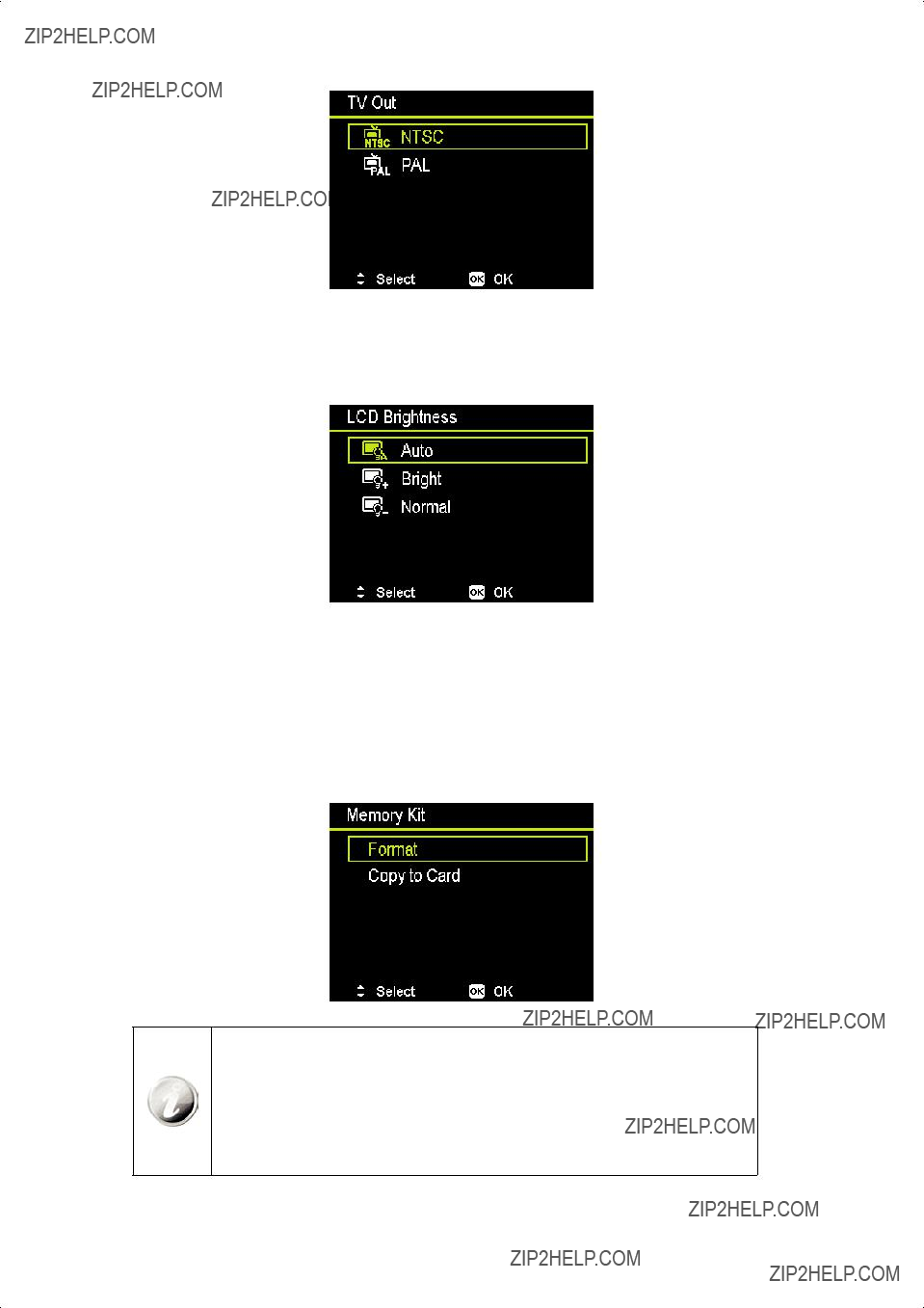
Setting LCD Brightness
Select a brightness level for the LCD monitor.
Setting Memory Kit
This utility formats the internal memory (or memory card) and erases all stored images and data.
Available settings are:
???Format. Select to format currently used memory.
???Copy to Card. Select to copy all files stored in the internal memory to the memory card.
???If the photos were saved in the internal memory when inserting memory card into the camera. You can use Copy to Card function in order to copy all photos from the internal memory into memory card.
???If there is a memory card inserted in the memory slot, the camera automatically saves all ???les to the memory card.
???If there is no memory card or the internal memory is empty, the Copy to Card function is disabled.
67

Reset All
Use this function to reset the camera to its factory settings. However, the following settings are exceptions and not affected by Reset.
???Date and Time
???Language
???TV Out
???Custom White Balance data
68
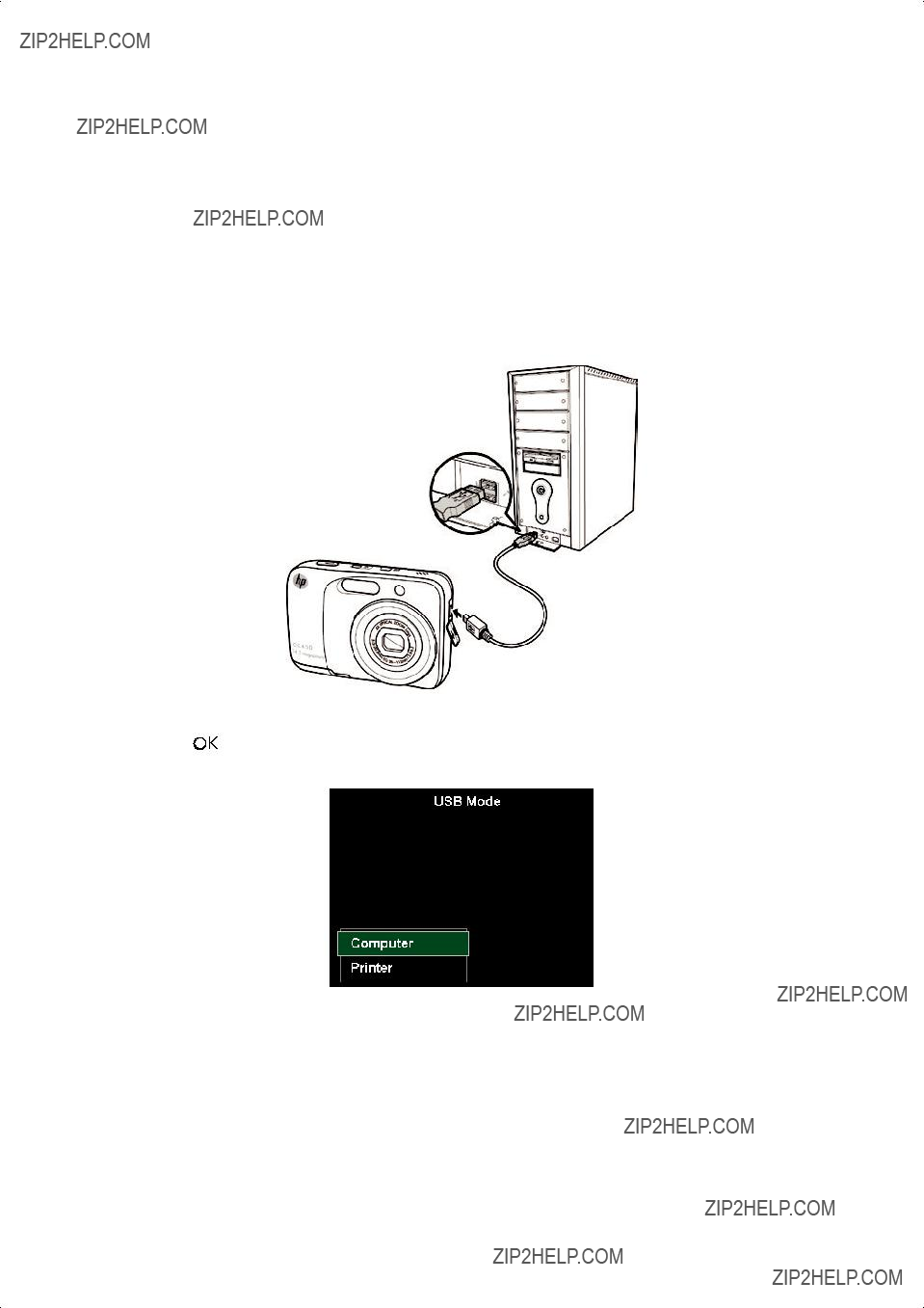
Making Connections
Connect your camera to: computer, or a printer.
Connecting the Camera to a PC
You can transfer images, videos and audio files to your PC.
1.Connect one end of the USB cable to an available USB port on your computer.
2.Connect the other end of the USB cable to the USB terminal on the camera.
3.Power on the camera.
4.The USB mode menu appears on the screen. Select Computer by using the 

 or
or 
 key and press the OK button
key and press the OK button  .
.
5. The PC starts to detect the connection while the LCD monitor appears Connecting???.
69

6.Connection established after PC MODE appeared on the LCD monitor.
7.Access the files in the camera by your PC.
???The camera???s internal memory and memory card would display as removable drives in PC.
???After the connection, no image is displayed on the LCD monitor.
70

Connecting the Camera to a Printer
Print your photos directly using a PictBridge compatible printer.
1.Turn on your Printer. Check that the printer is turned on, there is paper in the printer, and there are no printer error messages.
2.Connect one end of the USB cable to the printer while the other end to USB terminal on the camera.
3.The USB mode menu appears on the screen. Select Printer by using the 

 or
or 
 key and press the OK button
key and press the OK button  .
.
4.Enter the print mode and print the selected images.
For details on the following page ???Setting the Print Mode Menu???.
Setting the Print Mode Menu
Print Mode menu appears on the screen after the connection between a printer and your camera is established. Print Mode includes three major settings:
???Print Select. An image can then be selected to print.
???Print All. Prints all images.
???Print Index. Prints all images as thumbnails.
71

To set Print Select
1.Use the 
 or
or  keys to scroll and select an image for printing.
keys to scroll and select an image for printing.
2.Specify the number of copies. Use the 
 or
or 

 key to increase/decrease number.
key to increase/decrease number.
To set Print All and Print Index
Repeat the same steps 2 to 4, then enter printer settings.
To set Printer Settings
1.Use the 
 or
or 

 key to specify a print option.
key to specify a print option.
2.Modify paper size and quality by the 
 or
or  keys. Available setting:
keys. Available setting:
???Paper size: Default / A4 / 4???x 6???
???Quality: Default / Fine / Normal
3.Select Print on the screen for printing. Or Cancel to go back Print Mode.
Start Printing
??? LCD monitor appears ???Now printing??????.
After the printer has printed all the photos that had been selected, disconnect the camera from the printer.
72

Appendix
About Folder and File Names
Your camera automatically creates specific directory of folder in the internal memory cards to organize captured images, videos and audio files.
File Naming
File names begin with ???HPIM??? and followed by a
If the highest folder number is 999 and the highest file number exceeds 9999, the camera will display the warning message ???Folder cannot be created???. When this happens, try one of the following ways:
???Reset the file number. See ???Setting File Numbering??? on page 66.
???Plug in a new memory card.
Do not change the folder and file names in the memory card using your PC. It may be unable to playback the data using the camera.
73

Troubleshooting
74

Getting Help
Should you have a technical support question or your HP Digital Camera require service within the warranty period, please contact the original point of purchase or an authorized HP reseller in your country. If service is not available at those locations, please contact an HP Branded Product warranty agent from the support contact list provided below. A service agent will work with you to troubleshoot your issue and if necessary, issue a Return Material Authorization (RMA) number in order to replace your HP Branded Product. For warranty claims, you will be required to provide a copy of your original dated sales receipt as proof of purchase and the issued RMA number. You will be responsible for shipping charges when shipping the product to the service center. The service agent will provide you with an address and you will also be responsible for any shipping charges to the warranty service center. Once your product is received by this service center, a replacement unit will be shipped back to you typically within 5 business days.
Contact/phone Support:
75

Contact/phone Support:
76


P/N: 7525C00223A